Windows 11
Posted on
Microsoft is releasing Windows 11 starting October 5th 2021.
Vision version 2 has been tested with Windows 11 and works perfectly.
All articles are displayed in reverse chronological sequence. Please scroll to read all or choose a Category
Posted on
Microsoft is releasing Windows 11 starting October 5th 2021.
Vision version 2 has been tested with Windows 11 and works perfectly.
Posted on
An Urgent case
Dr Vijayarkar passed recently. He was an inspiration to many and thousands of homeopaths were devastated to hear of his death. Many years ago he called me from India unexpectedly one Friday night - I thought it might be a good way to remember him if I re-printed this article:
One Friday Night....David Witko and Dr Pravin Jain
Every now and again something happens that re-affirms your belief in homeopathy. This is a telling of just one of those times................
Last Friday at 7pm, at the end of a long day spent testing and re-testing the new (ISIS) Vision I was resting at home when the phone rang. The caller was my wife's sister, Sheila. Sheila is the lovely lady who happens to work in Miccant preparing and shipping all of those Vision and Akiva systems for our customers. She said 'David - Ruth (our tech support ladty at the time) has just been the phone....apparently Pravin from Mumbai just messaged her on MSN - someone has been taken very ill - can you please contact Pravin urgently?'
So I logged on right away and Pravin was waiting for me. Pravin is an associate of the Predictive School of Homeopathy in Mumbai. Apparently, a close family member of Pravin's mentor, the renowned Dr Prafull Vijayarkar, had been taken ill while on board a ship near the UK. In fact things were so serious that the man had been taken off the ship and transported directly to the Aberdeen Royal Infirmary in Scotland.
Pravin asked if I was near to Abderdeen as Dr Vijayarakar needed a remedy taking directly to the hospital. I replied that I was at least a 7-8 hour drive away!! A mutual contact was found who had already been contacted, Praveen Kumar who, with his generous and energetic spirit, had already obtained Nux vom 200c somewhere in Birmingham at 8pm on a Friday night and who had set off at high speed up the motorway to Aberdeen with his son.
I vainly tried ringing all 11 of our Miccant homeopathic customers in Aberdeen to see if we could short-cut an 8 hour drive. I received 11 voicemail messages (understandable on a Friday night).
Following further dialog with Pravin in Mumbai Dr Vijayarkar called me to explain that the man in question...'was 55 years old working as an engineer on the ship which was docked in the port of Aberdeen. The man developed a fever with shivering coming and going over 4-5 days which did not respond to treatment given on board ship.
He had fever with severe body aches and excessive pain in the lumbar region. The captain of the ship had given him Combiflam (an anti-inflammatory medicine) after which the fever suddenly came down and he perspired profusely. He phoned his wife in the USA and told her that after many days illness he felt much better because the fever had reduced so drastically. But he had become cold and clammy. After this his urine output started decreasing, and he had developed swelling on the face and body. On the 3rd day he started to develop breathlessness on talking.
He was then taken to Aberdeen Royal Infirmary where he was suspected of having a urinary tract infection. He checked into the hospital at 3.00 pm and by 5.00 pm he had found it more and more difficult to walk and talk. So he was advised that further investigation was required.Scans and x-rays showed pleural effusion and pericardial effusion and he was then admitted to the hospital. He was primarily diagnosed with renal failure as his Creatinine levels were raised up. His serum potassium also was increased. The doctors in the hospital suspected Acute Bacterial Infection spreading to the lungs and heart, leading to borderline cardiac enlargement with cardiac myopathy.
As the day progressed he became even worse and he started losing alertness and finally he lost consciousness and went into a comatose state. He was immediately moved to the ICU (Intensive Care Unit) and was put on life support.
The poor man was alone in Aberdeen, and there was no one with him. His wife and son and daughter in law were all in the USA. Only the colleagues on ship who had taken him to the hospital were with him . His wife wanted to get to the UK, but could not do so as she did not have the necessary VISA and the consulate of the USA was closed for independence day preparations.
Dr Vijayarkar explained that 'only Nux vom was needed in a case like this' and we had to get it to him before it was too late. Feeling a little helpless I called Praveen Kumar, who was further up the motorway, to offer just a few words of advice. I advised him that on arrival he was to say he was a family member who had been alerted to the condition of his relative and that he wanted to be with him. I further advised that he should not introduce himself as a doctor and certainly not to say he was a homeopath!
Dr Vijayarkar had advised me that in cases like this he always wanted the remedy to be rubbed into the cheeks of the comatose patient. So the fate of this man rested with the redoubtable Praveen Kumar - who had to drive 8 hours overnight, penetrate the ICU and unobtrusively administer the remedy!
When Praveen Kumar arrived he found the man on:-
And Praveen noted that a mild fever was persisting. Nux-vom 200c was administered on the cheek as instructed.
Within 25 minutes – the persisting fever came down. After 2 hours the man opened his eyes. After another 30 minutes – the doctors reduced the ventilator from 14 to 7. After another 30 minutes – the ventilator was stopped and withdrawn. By the evening hemodialysis was stopped and it was given only once more. The man had come to his normal senses in 4-5 hrs and started talking. One day later he was talking to everyone and spoke to Dr. Vijayakar on phone and was eating!
Fantastic!
Now - those of you who have attended any of my lectures and presentations may know of my talk on 'Embryology and Homeopathy' which is directly attributable to the pioneering work of Dr Vijayarkar. Normally I restrict my introductory lecture to the explanation of Herings Laws of Cure and Embryology as Dr Vijayarkar has taught me to pass on. With this case however I have a clear opportunity to show you how Dr Vijayarkar analyses such situations and how his great expertise can literally save lives!
Explanation and Analysis by Dr Vijayarkar:
The only 'history' which I could get was from 2 sources:-
1. The physician attending him in the ICU reported that when he was bought to the hospital that he was cold and clammy
2. His wife reported how he developed fever and how medication was taken and how he felt instant relief from this anti-inflammatory. She further said that, on the morning of admission, when he was talking to her on the phone, he sounded very irritated when she did not answer his questions properly. This was very unusual for an otherwise calm person. She further stated, that he told her of passing less urine despite his thirst being very good. On that day whilst on the phone, he would talk only about his health and did not even ask about other members of the family.
So what was the situation? How do we homeopaths look at such a case?
Sudden renal failure – the kidneys and other organs were failing fast. All reports of urine culture and sensitivity were showing no presence of infection. But the CT scan showed necrosis of kidney tissue. This immediately leads us to the SYPHILITIC Miasm i.e. Onset of destruction in kidney tissue. Our remedy therefore needs to be known as a syphilitic remedy.
Sudden development of renal failure, pleural effusion and pericardial effusion. Within 2 days, the disease had spread from renal shutdown to cardiac myopathy. So something which started as an inflammatory process (psora - inflammation of kidney tissue) proceeded to the destruction of the tissue (necrosis of kidney - syphilitic) with an intermediate stage of sycosis (pleural effusion and pericardial effusion)
Therefore SPEED = FAST and therefore the remedy we need to administer also has to be fast (acting).
Causation? There was no obvious mental causation. The only ascertainable causation was the taking of the anti inflammatory medicine.
Physical Generals - Thermals = Chilly
Thirst – his wife said, inspite of his thirst being good, his urine output was reduced.
Mental disposition – He was irritable and was angry when obliged to answer.
So which remedies are Angry when obliged to answer and also Chilly?
Rx to immediately consider: Nux-v, Ars, Phos-ac.
However he did not have the anxiety and anticipation of Ars. Also he was not dull and sullen as Phos-ac would be.
Nux-v is a fast remedy that is angry, chilly, thirsty, and overall covers abuse of allopathic medications.
Before the allopaths could even diagnose what to do, homeopathy had cured him!
Added Note:
Prafull was giving this explanation entirely from memory over the phone without consulting any repertories or books. I worked this small case into Vision and present to you the analysis:
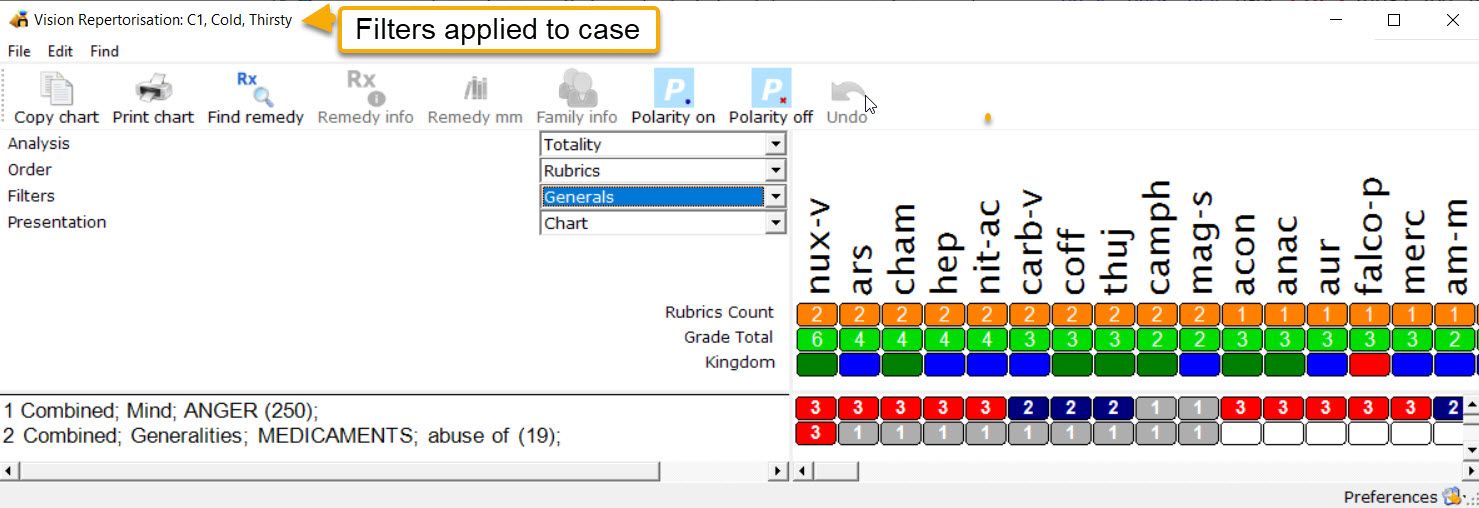

Posted on
Vision has many different ways to help you analyse/repertorise your cases. The default is always Totality but by making adjustments to your case clipboard, you can choose other ways of analysing cases.
Totality (the default)
This default analysis ranks remedies by how many rubrics they cover and then by their score (i.e. sum of the grades in the rubrics). This is always the initial display as it has been found most useful in practice.
The aim of any repertorisation is to give you a set of good remedies to consider. Often, polychrest remedies show at the top of the repertorisation chart simply due to the frequency that they appear in all of the rubrics. The polychrests can, in this way, overshadow smaller remedies that may be good candidates for use in the case.
All other analysis types avalable in Vision aim to boost these other remedies, where appropriate, to draw them to your attention.
You need to make use of settings on the case clipboard(s) in order to use these alternative analysis strategies. To do this on each clipboard you select and highlight the rubrics you want to work with and then click appropriate weighting buttons so that Vision knows the importance of your settings:-
When your clipboard is setup the way you want it click Repertorise and change the Analysis Type from Totality to whichever anslysis type you wish to investigate:
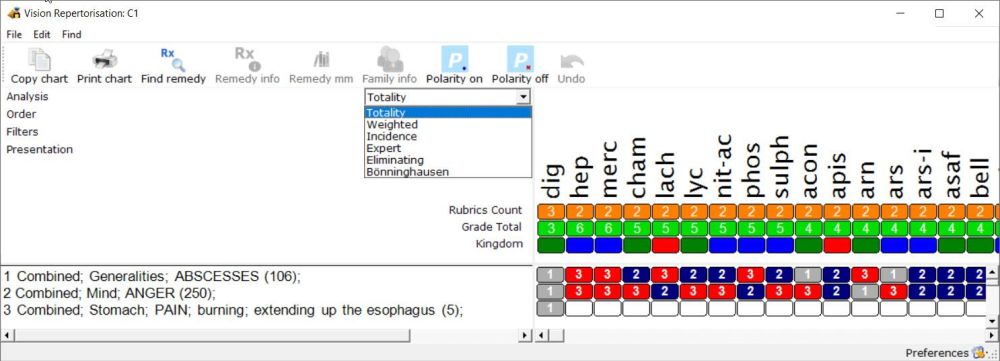
Following is an explanation of the various ways you can analyse your cases.
Weighted
In any clipboard you can assign rubrics an 'importance' or 'weighting'. All rubrics are initially set to a weight of 1 by default but you can upgrade each up to weight 5. When you then repertorise you can choose 'Analysis' in the dropdown and select Weighted. This calculates a score for each remedy by multiplying the normal grade by the weighting and adding them all up together.
This analysis method aims to boost all of those remedies present in the more important rubrics (as per your 'weight' or 'importance' settings). Many homeopaths are familar with using 3 weights of rubrics but Vision allows you up to a level 5 importance weighting.
Incidence
Using any weightings you set for rubrics in the clipboard this analysis calculates a score for each remedy based on the number of rubrics they occur in and the boost provided by any weightings you assign.
It is therefore a combination of Totality and Weighted to give a 'smoother' chart.
Eliminating
You can mark any rubric(s) on the clipboard as Eliminating. This analysis then excludes any remedies that are not in the eliminating rubrics.
So it is as if you were saying ' I do not even want to consider remedies unless they are in this/these rubrics I have marked as eliminating rubrics'. Often there wil be only 1 rubrics that is so important you wish to mark it in this way but Vision allows you to amke any rubrics as Eliminating.
Some homeopaths refer to this as 'crossing' rubrics. This analysis only displays remedies that are present in every rubric you mark as Eliminating.
Causative
You can also mark rubrics as Causative on the clipboard. If you do, then on the repertorisation chart you can choose Expert analsis and the remedies in the causative rubrics are given a big boost
Causative means all the patients problems started from this e.g. a Grief and can be a very important thing to consider in your analysis.
Expert
This is a special analysis calculation that applies up to 5 different factors (see above) and creates a score for each remedy based on all of these factors combined. When using the Expert you definitely need to assign careful weightings to the rubrics. The Expert uses these and also has other 'behind the scenes' calculations to boost the smaller remedies. It also takes into account the size of rubrics (i.e. how many remedies are present in the rubric) looking for those Strange, Rare and Peculiar rubrics. It automatically applies any Eliminative and especially Causative settings you make for the rubrics. (Causative means all the patients problems started after this e.g. Grief).
Expert applies all of the different ways you can analyse and puts them all together in one chart.
You will often see smaller remedies elevated (when appropriate in the case) by using Expert. This can be a good way to see remedies other than polychrests.
You can adjust the settings of the Expert analysis to suit how you practice, by clicking Settings, Expert in the main toolbar. We only recommend you consider doing this if you are researching or exploring different settings that may better suit your own way of analysing cases (the default settings we have found to be very useful in everyday practice over many years )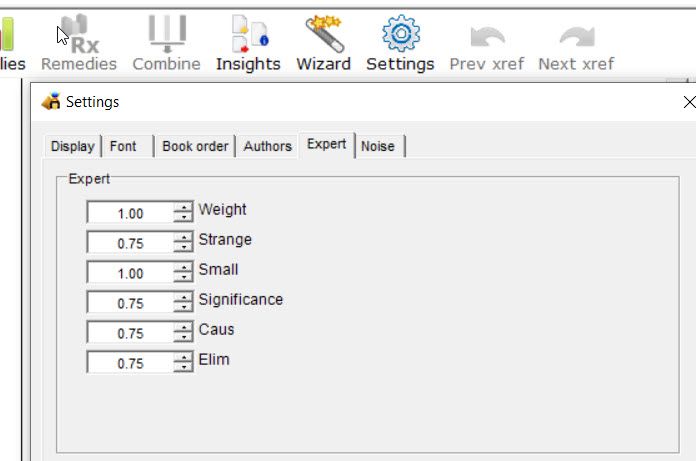
Multinalysis, MultiCB Analysis
As shortcut alternatives to the normal Repertoisation button in the toolbar there are 2 other analysis methods avalable. You access these by clicking on the little black triangle on the right of the Repertorisation button on the toolbar.
As their names imply these are simply shortcut ways to repertorise.
MultiCB shows a quick chart of the leading remedies for each clipboard you have used. (if you have only used one clipboard in your case then this is of no use). If you do use different rubrics to seperate your rubrics (e.g. Mentals from Generals, from Locals) this MultiCB analysis shows you the leading remedies for each clipboard on a handy little screen to save you have to go in and out of the normal repertorisation chart for each clipboard.
Multianalysis shows a quick chart only for clipboard 1 rubrics showing the leading remedies for each type of analysis that is possible (as described above). It is a shortcut way of seeing the leading remedies in each analysis type all together on 1 little screen withouth having to go in and out of the main repertorisation chart.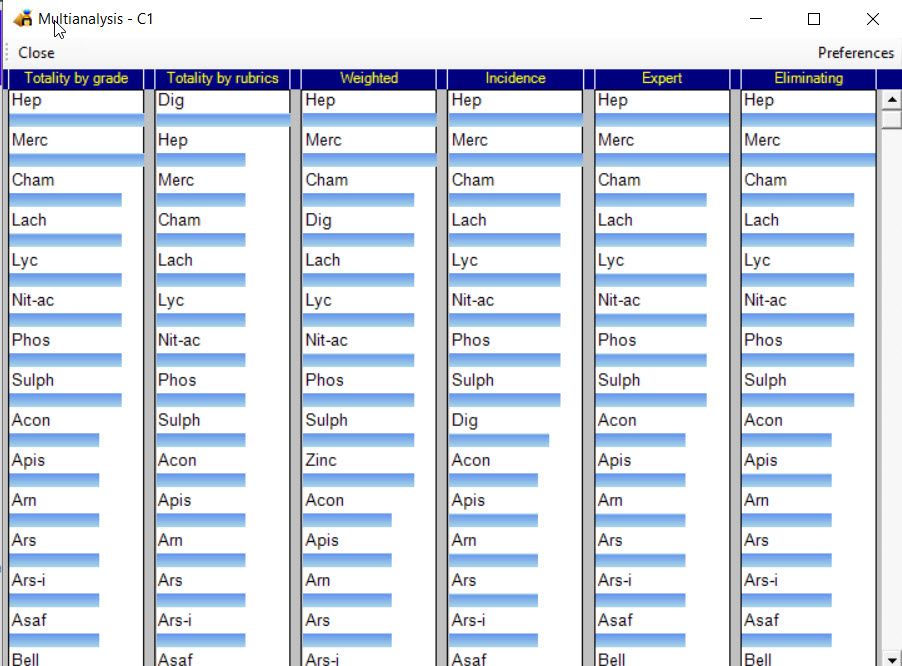
Posted on
A brand new version of the Vision software is available. Version 2 is available for Windows and Mac computers.
Vision v2 has been re-engineered to take advantage of recent developments in both Windows and macOS whilst retaining the same overall 'look and feel' (to make transition from version 1 easy for existing users)
To watch videos and read about the improvements made in Vision v2 click here.
We ran an anonymous survey of our advance user team and asked for their opinion on Vision version 2 - here are some results:
"I think it has improved Vision massively , it is such an intuitive fantastic programme. Lots of features have made it quicker and easier to access extra information."
"This is a significant enhancement to Vision. It has all the familiar features known to us so that the new features feel intuitive. It's smooth-acting and visually pleasing. The new word-processing tools feel natural. Of great benefit is the interface with the patient database."
"Amazing piece of technology - the only software needed in clinic...."
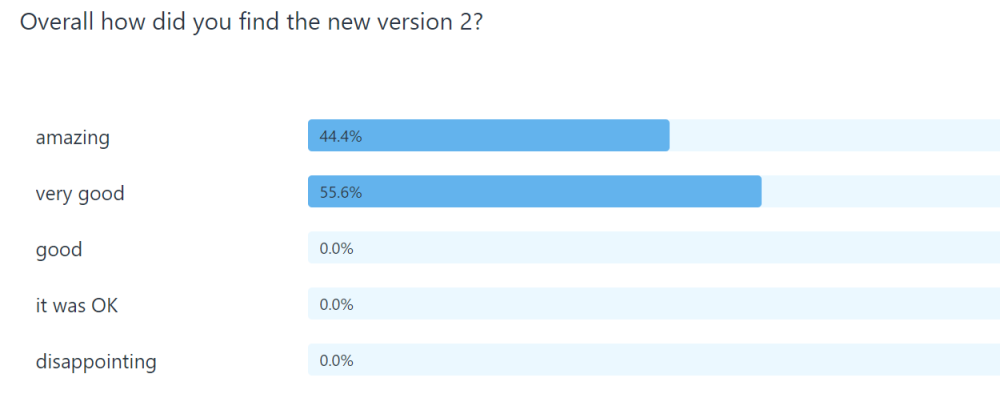


Posted on
Complete Repertory 2020
This edition of the Complete is available as an option to purchase with Vision. This edition of Complete cannot be added to the dongle version of Vision - it can only be purchased for use with a product key version of Vision version 2.
The author offers an upgrade to Complete to users of previous versions.
New information incorporated:
To add Complete Repertory 2020 into your Vision click here.
To upgrade an older version of Complete into the latest 2020 edition click here:
Please note: Complete 2020 is available Vision for Windows and Vision for Mac.
Chart to show you the content of the Complete compared to Kent, Synthesis and older versions of the Complete :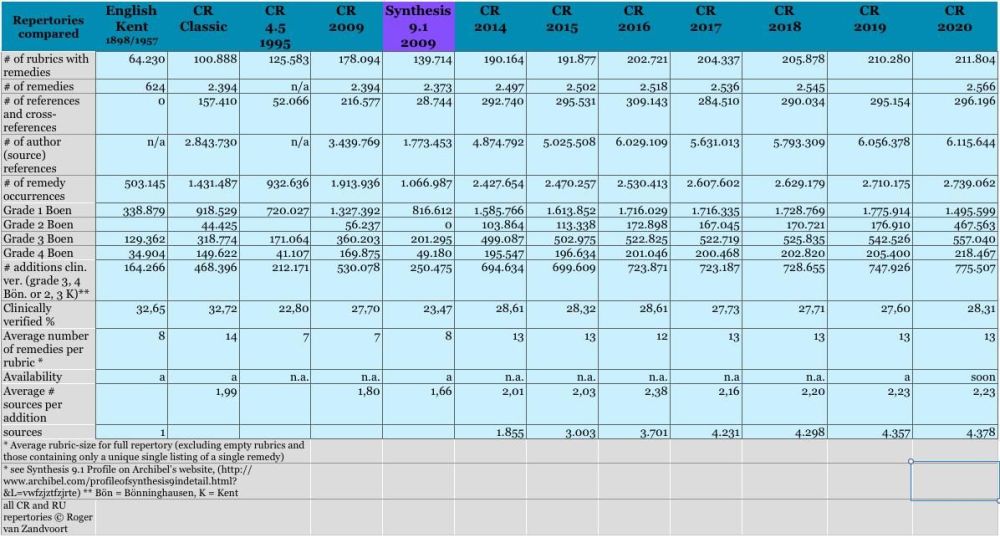
Posted on
Jeremy Sherr's latest v4 2020 update to his QRep is available for Vision v2. This edition of QRep is available as an option to purchase with v2 of Vision. It cannot be added to Vision v1 - it can only be purchased for use with Vision v2.
QRep edition 4 adds:
4 new qualities
Rather than spending a lot of time searching the repertories for all the rubrics you need these qualities allow you to quickly select a quality that encompasses all remedies associated. A huge time saver that also makes sure you never miss a remedy through rubric selection! These are the new qualities added in version 4:
Closed People
Reserved, introverted or reclusive persons with suppressed feelings or aversion to or inability to share feeelings or opinions.
Duty, Responsibility
All issues connected to increased, decreased, desire for or aversion to a sense of duty or responsibility
Dyslexia/Dyspraxia/Dyscalculia
For use when any of these neurological disorders are pronounced.
Spatial Disorientation
Where there are issues connected with innacurate judgement of size or distance and sense of direction and orientation.
Enhancements to existing qualities
Many adjustments and refinements to the grades of remedies in all existing qualities have been made.
Lanthanides and Noble Gasses have been throughly upgraded and many new remedies are now included for the first time.
Jeremy has paid particular attention to making sure those remedies listed as Primary Remedies are highly accurate. These remedies will definitely cover the aspects of the quality - even if they are a relatively 'small' remedy.
As a reminder here are the remedy grades in Vision and the meanings:
4 points - Green, Caps, Underlined - Primary remedies. Remedies that have this quality as a major and essential characteristic.
3 points - Red, Caps - Potential candidate for Primary remedies - Currently classed as experimental for Primary grade - but definitely having the quality as an important issue in their pathogenesis - hence high grading.
2 points - Blue, Italic - Remedies definitely belonging to the quality.
1 point - Black, Regular - Experimental. Remedies which currently have only a minor symptom of this quality and are not yet confirmed.
Here is Jeremy's suggestion for getting the best use of QRep:
"The Q-Rep is not a substitute to the existing repertories, but a compliment to them.
To get the best results from this repertory, I suggest that you use a few qualities that are essential and major themes of the case. You can then use the Qualities you see in the case in conjunction with rubrics or affinities from other repertories.
Here are a couple of examples:
Money + Home qualities combined with ‘Lung inflammation of’ from another repertory
Low self esteem + Water qualities with ‘Headache pulsating’ from another repertory
You will be amazed to see how, when using a few rubrics with 200 or 300 remedies, the result quickly boils down to only 20 or 30 remedies which are then easy to chose from by combining with a conventional repertorisation or from your understanding of the case.
Of course you can use these Qualities in any sequence or combination you want, e.g. if you wish perform a repertorisation from another repertory first and then supplement with one or more Mental Qualities.
Remember : Use the Minimum Rubrics of Maximum Quality"
Add QRep to your Vision software
QRep is a repertory you can purchase to use with your Vision software. If you are a user of a prior version of QRep the author offers an upgrade - see our Shop under Upgrades for the cost and to order.
https://www.miccant.com/ourshop/prod_2544985-Jeremy-Sherrs-Repertory-of-Mental-Qualities.html
David Witko Fellow Society of Homeopaths UK (Hon)
Posted on
More information regarding Coronavirus.
There has been a flood of information provided by the homeopathic profession over the past few weeks. In this article I have attempted to condense the information into a format that is more easily 'digestible'.
The information presented here has all been given freely for me to share. I cannot endorse or recommend any information and I am simply passing this information on to you for further research.
Miranda Castro (USA)
Has presented a chart of remedies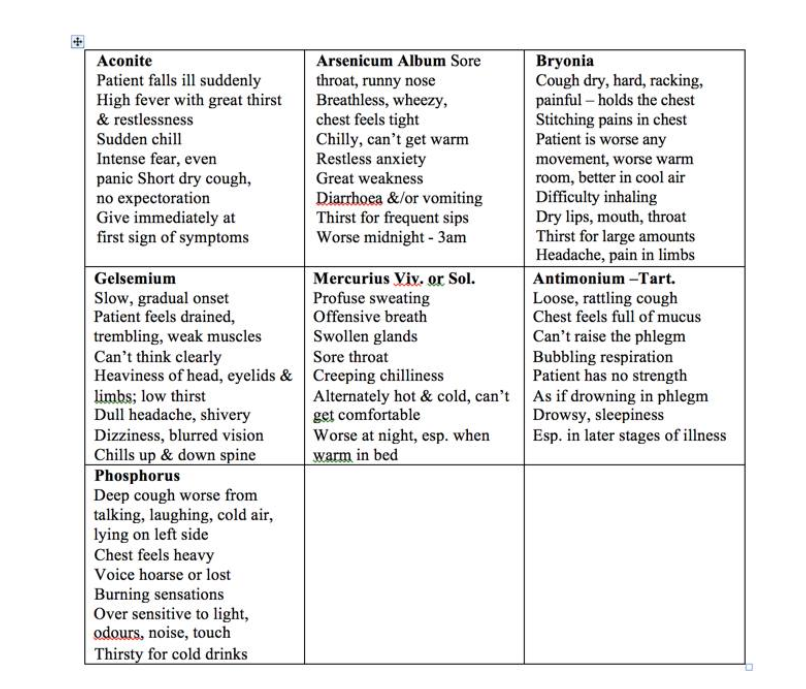
Dr Ajit Kulkarni (India)
Below is a link to an in-depth article by Ajit. I encourage you to also read the contributed questions and comments at the end of that article.
Ajit suggests Arsenicum album as the 'Genus Epidemicus' for prophylaxis. In his words "There is a tussle between Arsenic album and Sulphur. My mind is also thinking of Carbolic acid and Hippozaeninum as both covering the range from cold to severe pneumonia and septic shock. But yet as GE, I suggest ARSENICUM ALBUM as a homeopathic prophylactic remedy for the COVID-19 outbreak."
Whatever remedy is given for an actual infection, he suggests giving it in 1M potency frequently, every 3 - 4 hours, or when at a critical stage every 15 minutes.
He also suggests a Treatment Plan :-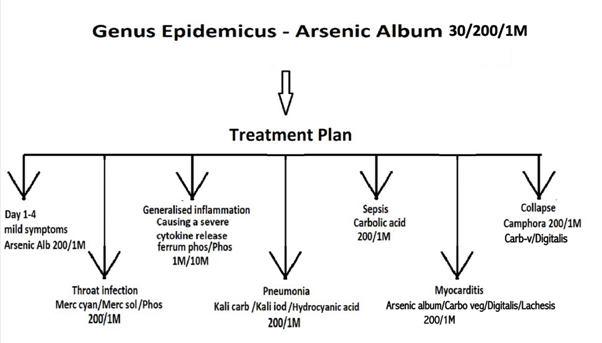
Here is a link to the full article:
https://bit.ly/3aoFJwi
Isaac Golden (Australia)
Isaac is renowned in the field of prevention of illness and offers an essay based on his own findings and also his experiences on visits to Cuba. In addition to the prophylactics widely suggested by others, Isaac makes his own suggestion based on complexes. Here is a quote:
"given that there is some uncertainty regarding the Nosode and that there are many suggested GE remedies, if I was preparing a combination remedy it would look something like the following: Influenzinum triple nosode M + Pneumococcinum M + Bacillinum M + Arsenicum Album 200 + Justicia Adhatoda 200 + Gelsemium 200 + Bryonia 200 + Antimonium Tartaricum 200."
Here is a link to the full article:
I am compiling and condensing further information and will release it as soon as possible.
As said previously above I cannot endorse or recommend any information provided and I am simply passing this information on to you for further research.
David Witko
Posted on
Additional information regarding Coronavirus.
The findings, suggestions and observations listed below are extracted from various sources freely given to me. I cannot endorse or recommend any and I am simply passing this information on to you for further research.
There is quite of lot of information in this email so please excuse the length! Most of it is from Jeremy Sherr who is working with a large network of homeopaths who are actively working with real Covid-19 cases and patients. I have spoken to Jeremy and he is happy for this information to be shared with you.
Robin Murphy suggests Elderberry (Sambucus nigra) as a preventative tonic to help boost the immune system (note: not as a treatment once infected). This can be taken as a Tea, Wine, Lemonade drink or Tincture). The studies on Elderberry that show its benefits have only been observed in healthy persons.
He also refers us to books on Pneumonia from classical homeopaths such as Borland, Nash and Pulford which may prove useful. (these books are contained in your Vision system if you purchased the Rhodium Library with your software)
Remedies for SARS may also prove helpful (as Covid-19 is more accurately referred to as SARS-CoV-02) :
acon, ars, ars-i, bac, bapt, bell, blatta, bry, camph, carb-v, carbn-s, caust, dulc, eup-per, gels, influ, ip, kali-c, lach, laur, lyc, merc, op, oscillo, phos, pneu, pyrog, samb, sang, seneg, spong, tub, tub-a, verat, verat-v.
Those of you who are Vision maestros could consider adding this as a new rubric into your system for easy reference!
Robin also presented this slide of Pneumonia rx to bear in mind: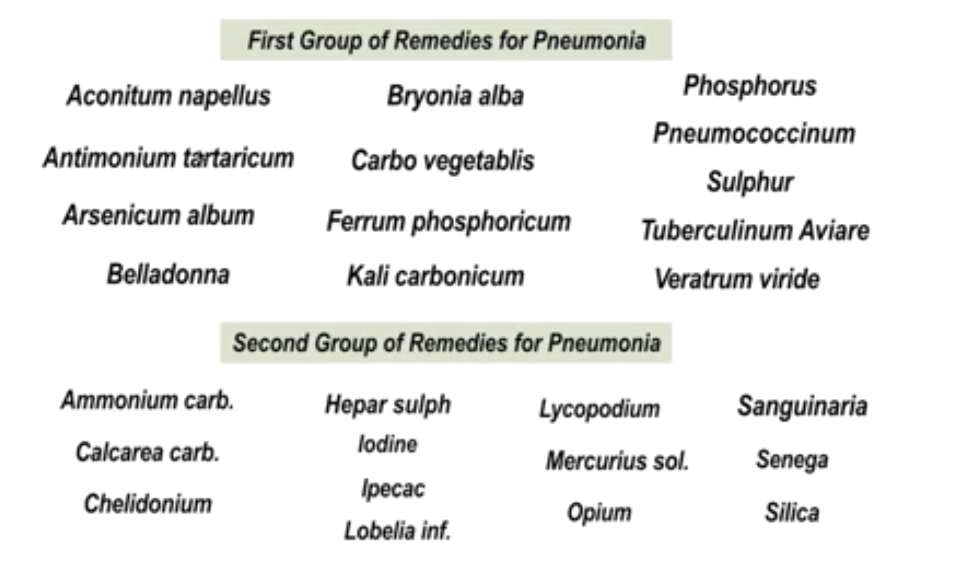
ARHF recommends the following protocols:
Herbal Prevention - Astragalus (or any combination that contains this). Optimal if this can be combined with Echinacea, Vitamin C and Zinc.
Other herbal suggestions are : Reishi mushroom, Colloidal Silver, Thyme.
Homeopathic suggestions based on observed symptoms :
Justica adhatoda 3x (or 3d) once daily 10 drops in a teaspoonful of water
Arsenicum album 30c
Bryonia, Lycopodium, Phosphorus, Gelsemium and Eupatorium perfoliatum (ordered in likelihood of being needed)
A new digital resonance has been created and is freely available for use:
https://www.arhf.nl/coronavirus/
Jeremy Sherr
Cases continue to be submitted to Jeremy for analysis. Now that New York has seen a huge increase many homeopaths are seeing real Covid-19 cases and using remedies to help. As I write this email over 200 cases have already been recorded and analysed and a database of over 350 unique symptoms recorded. All of these symptoms are being qualified and the number of patients showing each symptom counted - this is already highlighting the common symptoms and also, most importantly, those symptoms which we call SRP symptoms that are occurring in substantial numbers of patients. It is the SRP rubrics that really help us focus in on the required remedy.
The cases received from homeopaths 'in the field' indicates remedies are working. When correct remedies are found, homeopaths are reporting that they seem to be stopping the virus in its tracks or are reducing the severity of symptoms by 30% (i.e. the patient still goes through the illness and recovery but with reduced severity). These patients are recovering but not in a 'spectacular' way. This makes Jeremy think there are still better remedies to find than the standard ones we are currently giving. The ideal response to a remedy is that they wake up the next day and everything is very much better! An initial small amelioration followed by aggravation is a bad sign.
Before I share information on remedies here are a few pointers from Jeremy:
Here are some slides and comments from Jeremy's webinars. The three observed stages are shown here along with the leading rx for each stage: 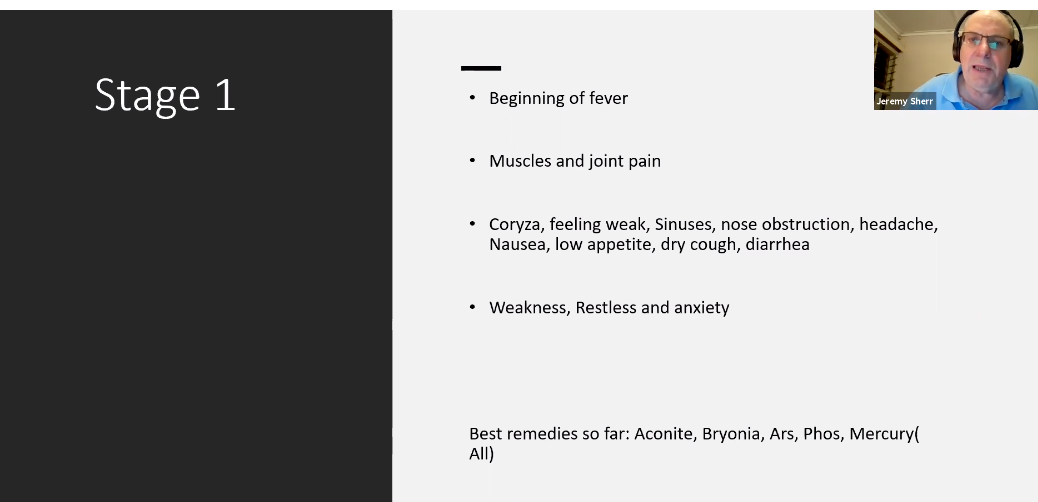
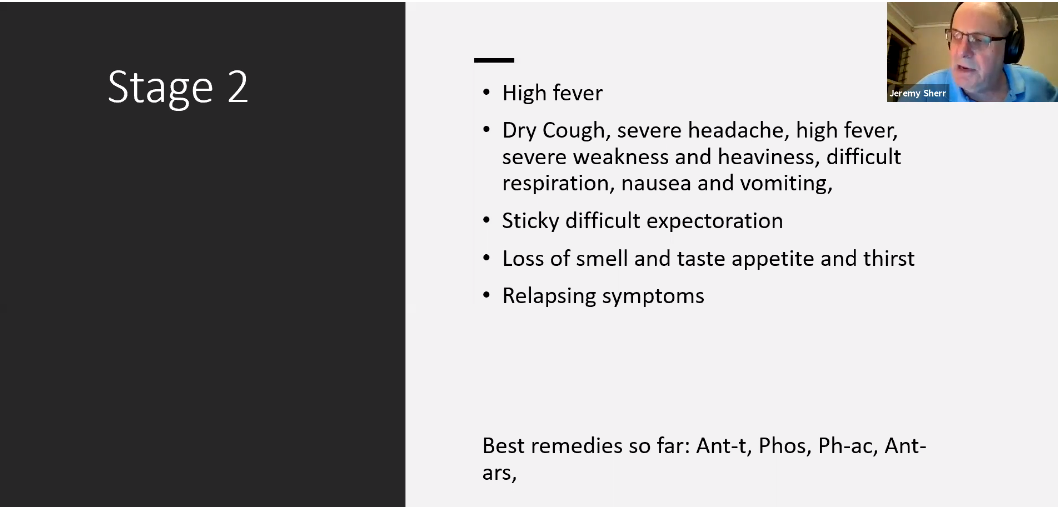
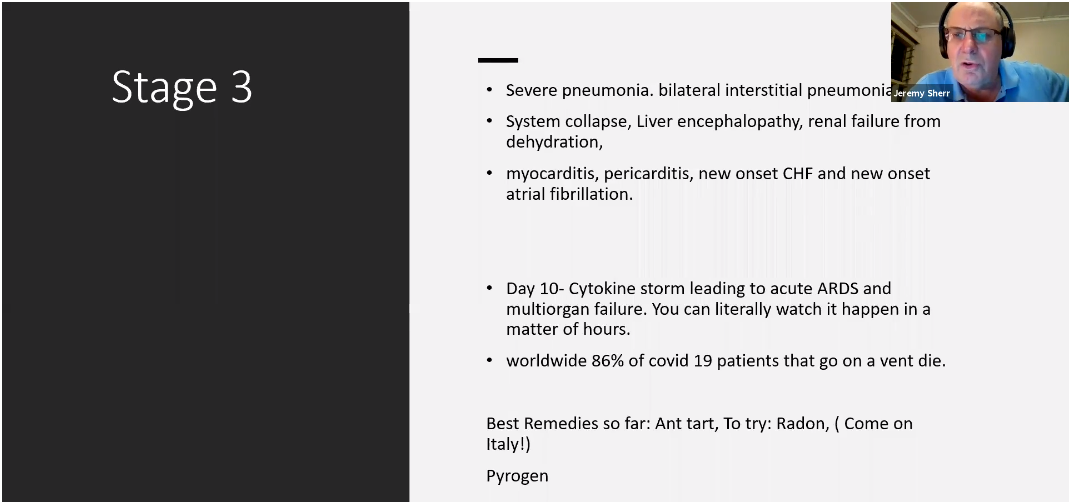
Some observations received from New York. Good results when symptoms clear. Camphor is failing even in collapse. Some patients 'stalling'. Re-inforces to Jeremy that different (better) remedies still need to be found.
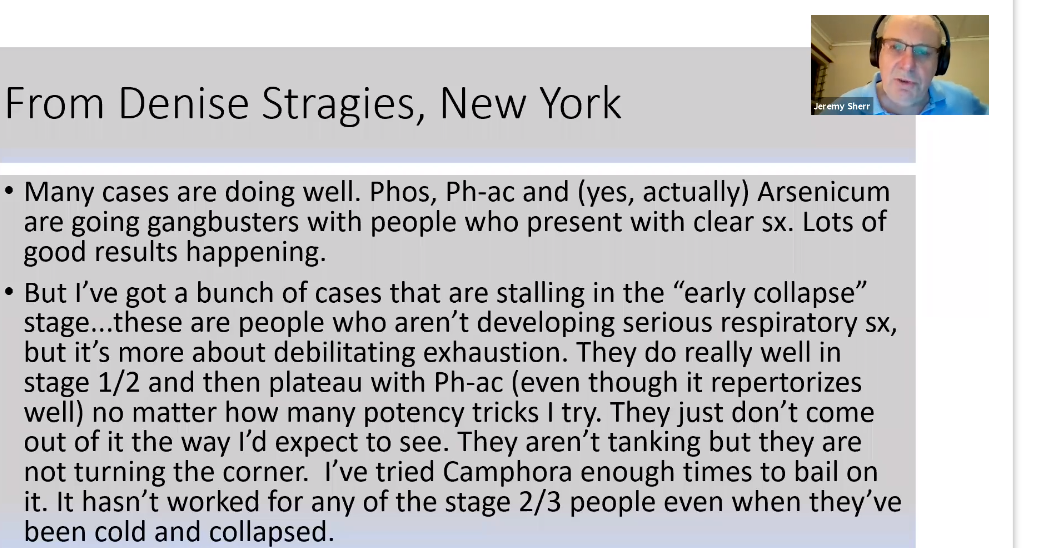
Observations about remedies from Jeremy:
Ant-tart is proving helpful in many cases. The sense of 'drowning' is a big SRP in many cases requiring it. Loss of taste and smell also leads to Ant-tart.
Possibly the 'sensation' of the pandemic is this - 'Too full! Must expel forcefully'
The rx Croto-tig can give immediate relief. This is the best kind of reaction! (Although we know this as a remedy for diarrhea and the bowels, it is the 'explosiveness' of the rx and the relation to this forceful expulsion even from the lungs that leads to its consideration - DW) This may be one of the remedies that proves to be invaluable in this pandemic although it is to soon to be certain.
One SRP that has been observed is that sometimes the mucus in the lungs is like 'honey'. When patients lie down they can feel it almost 'trickling down' inside the lungs just as honey would. Sticky and trickling. This leads Jeremy to the remedy Ars-i. When repertorising the most commonly seen symptoms of Covid-19 we see Ars and Iod near the top of the chart and so these two substances together in ars-i seem ideal! This SRP is also a good indication:

Another smaller remedy that shows very promising signs of being one of these 'spectacular' remedies is SPIG. It has the SRP's relating to 'needles, stabbing eyeballs', 'pressure skull' and 'spear-like pains'. It is too early to confirm but shows great promise when these SRP's are present.
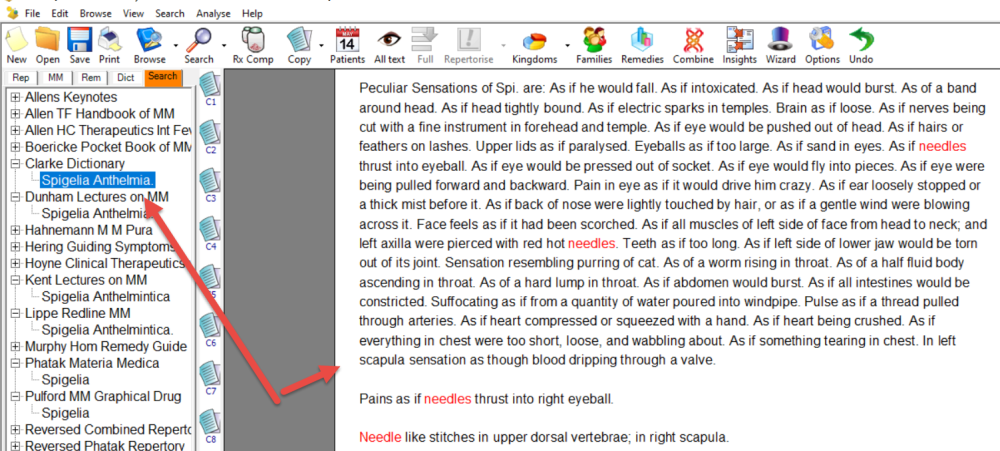
The final rx to remind ourselves of is our old friend KALI-BI which is proving useful. We see patients are better at night but they wake up in the morning drowning in mucus. (c/f ant-tart of course). Also they are seen to have the loss of taste and smell. > lying down is very unusual when there is a lot of mucus in the lungs and leads to this remedy!
Jeremy has also identified the most commonly occurring symptoms for this pandemic. As you may need to reference these rubrics regularly in any cases you see, I have taken his rubrics and created a Vision case file of them. Then, when I have a new case, I can open up this case of common rubrics and all of the potential rubrics have already been selected and are on clipboard 1. No need to search and find them again in the repertories. All I need to do is drag those common rubrics presenting in the case onto clipboard 2 - and also add any new rubrics for the current case onto clipboard 2 and repertorise together.
Should be a good time saver! If you want a copy of this case email [email protected] and request it. I can provide the case file so you can use it in your own Vision system. Here are the common rubrics identified by Jeremy: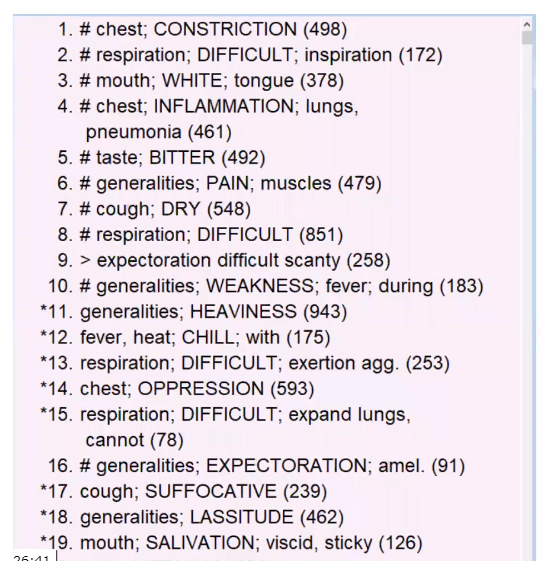
I hope this information has proven to be of interest to you. We continue to be grateful to these homeopaths for freely sharing their findings with the community
Kind Regards from David Witko and the team at Miccant Homeopathic Software.
Posted on
For many years modern repertories have continued to add more and more remedies and rubrics. This work is derived from new provings and also historical records. Dr Pravin Jain disagrees with this approach of continual enlargement and addition and prefers to only work with rubrics and remedies seen to have worked in practice.
Furthermore his way of practising works well when the remedy prescribed precisely matches the patient's disposition (or temperament). Therefore Dr Jain will only use remedies in the repertory that adhere to this fundemental principle.
This new repertory is exclusively available with the Vision software system. To learn more about Dr Jains approach please watch this video presentation:
Posted on
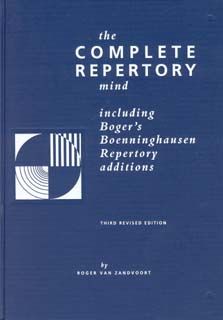
Complete Repertory 2018
This version includes more 20th/21st century work. Many additions have been incorporated espeically from Karl Stauffer’s Symptomen-Verzeichnis 1929, since it contains relatively many additions from smaller remedies (Aqua marina, Calcarea caustica, Vipera beris, Mephites, Natrum nitricum, Picricum acidum etc.) From this source 106.081 additions were made.
New contemporary provings include: Morpho menelaus and Sequoiadendron by Hélene Renoux, Crataegus oxyacantha by M Stoschitzky, Acherontia atropos by Evelyn Feltes & O Neuhoefer, Agaricus phalloides by Peter König & D König, Betula alba by Jörg Wichmann, Helix costa by Todd Rowe & Desert Insitute, Astacus fluviatilis by D Drach & F Swoboda.
Handwritten Repertory Additions in Kent’s Repertory by Roger Schmidt, Pierre Schmidt’s brother, who worked in San Francisco, were added.
In this edition emphasis was given to some specific remedies: Falco peregrinus, Astacus and Mandragora, in that both provings and as much cases as could be found were incorporated. This practice will continue in the next incarnations of the Complete Repertory when this is consdiered worthwhile for some remedies.
From Hans Eberle & Friedrich Ritzer lots of clinical confirmations were added for Eagle, Electricitas, Uranium metallicum and Aqua Hochstein.
To add Complete Repertory 2018 into your Vision click here.
To upgrade an older version of Complete into the latest 2018 edition click here:
Please note: Complete 2018 is available Vision for Windows and Vision for Mac.
Chart to show you the extent of content of the Complete compared to other repertories including Synthesis:
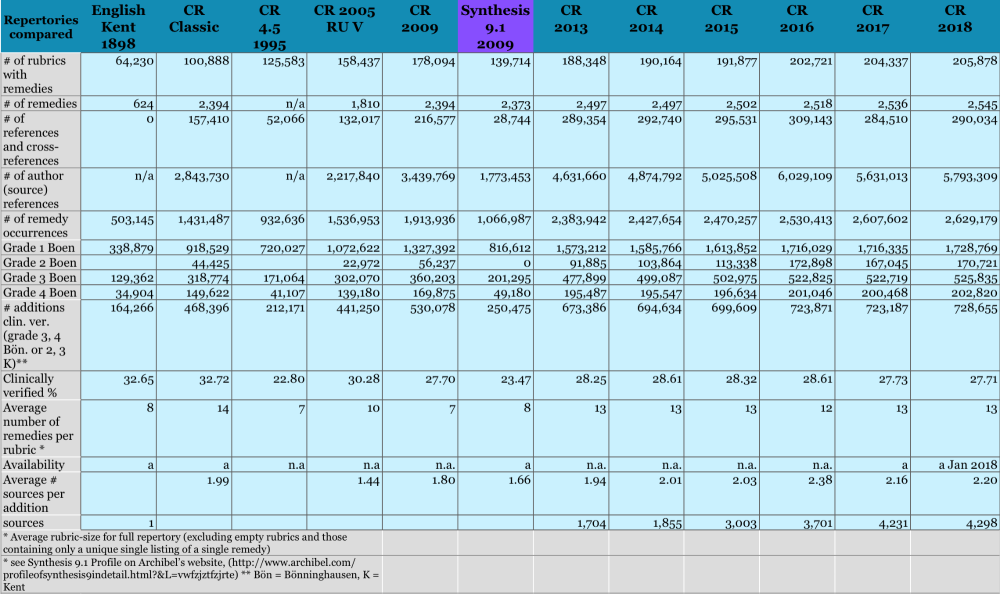
Posted on
Families in Homeopathy
Melanie J. Grimes, R.S. Homeopathic (NA), CCH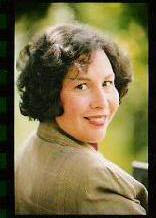
With the increase in the number of homeopathy remedies, from the 100 or so in Hahnemann’s time to the many thousands today, different systems have evolved to track, compile, reference and eventually prescribe the simillimum.
Computers have greatly enhanced our search abilities, enabling a much more specific exploration. With this renewed ability, comes elevated responsibilities, as is true in all areas of life.
The responsibility we now face is to accurately conduct provings, to accurately extract the data, to accurately add data to the repertories. People of integrity are now charged with organizing repertories and applying standards, as the gatekeepers of this accuracy.
The bottom line is the patient. Can we more accurately and specifically prescribe for each individual. And do the ends justify the means? Most important to consider is ease of use, speed, i.e. time needed to find a correct prescription, and short training period to learn.
When I began studying homeopathy in 1972, repertization was done by hand on paper. Daily, I am grateful to the computer programmers who spared me and us all from this tedium. In fact, I do not think homeopathy would have had the revival it now enjoys were it not for the computerization of the repertory and materia medica databases.
This brings us to the subject of families.
Each remedy is a unique entity, as each individual is a unique entity. That being said, there is something to be gained by grouping like with like. A creature that lays eggs and flies is more similar to another egg-laying flyer than to, say, a fur bearing, four legged live bearing creature, which eats egg-layers for breakfast.
What constitutes family? What parameters are needed to include a remedy in a family? Can you group animal, vegetable, mineral remedies in one family? Do we need families?
My opinion is that organization is the keynote of science and society, and any system that seeks to organize itself is a sign of intelligent design.
Rather than bicker over whose organizational system is right, I say, the proof is in the pudding. Or it will be, when an increasing number of cured cases raises homeopathy to greater visibility as a curative healing modality. Or not. The truth will out.
Families of plants have, even in recent times, been classed by the color of their flowers. This is a simple classification; easy for even a child to do and most useful if you are arranging flowers on the dinner table. A classification of plants by flower color is not the best for homeopathic similitude, because the ability to produce a red or white or yellow flower doesn’t indicate a particular characteristic commonality, as say,the ability to produce fever. What is useful to homeopathy is a classification that allows a list, or rubric if you prefer, with any remedy that might treat a specific system. The current use of “families” is sometimes useful in this regard, and sometimes not. Again, time will tell.
One thing all homeopaths agree on is that the words of the patient, or perceiving the words and actions of the patient, leads to finding the remedy, if not the cure. Wouldn’t it be wonderful if somehow the patient’s words could be used to search for a remedy, without the cumbersome step of translating into 19th century language? (How do you find “fear of flying” in Kent’s Repertory?) Or remembering where you last saw the rubric, “generals, worse heat, worse waking, left side, pain in spots”, or was it “left side, pain in spots, heat agg.? The new computerised word-search databases have been a mighty asset in these situations.
Miccant’s new software, Families, is another leap forward in this regard. It gathers every word in the case and analyses its probability. I think this is a brilliant use of our modern technology, and provides a way into a case without repertization.
What? No repertory? Homeopaths will scream. But your complaints fall on deaf ears, as I remember the day when those same individuals complained about losing paper and pencil repertorization.
The bottom line is this. Great skill must still be taken in case taking, as garbage in = garbage out.
The case will be found in listening, perceiving what needs to be cured in the case. If a practitioner can do his/her part of the work, it, the Families software, will greatly aid in the rest.
Melanie Grimes
Award-winning Screenwriter
Professional Homeopath
Adjunct Faculty Bastyr University
Author and Medical Editor
Journal Editor: The American Homeopath
Board Member: Pacific Northwest Writers’ Association
Melanie Grimes has been a writer since the age of seven. Her published works include books, journals, articles, essays, screenplays, teleplays, and librettos.
Melanie began studying homeopathy in 1972 and has been a registered member of the Society of Homeopaths (NASH) since 1992. She is the editor of The American Homeopath, and lectures internationally.
To purchase the Families software click here:
http://www.shop.miccant.com/ourshop/prod_3407348-Families-v3.html
Posted on
Ever had one of those cases that you can’t get to grips with? Having trouble finding a remedy that covers the case well? A Families based approach to case analysis can be used to clarify the case.
What if you really want to use a Families oriented approach but don't know how to? Now you can set aside your rubrics, symptoms and modalities and let the innovative 'Guided Analysis' gently lead you towards the most indicated remedy using our Families software.
Some practitioners use the same methodology for each patient and others choose the methodology to suit the patient.
Here is an introductory video:
Posted on
David Witko, FSHom (Hon), DiHom, FBIH
I have been developing homeopathic software for nearly 30 years and while I have received wonderful feedback telling me how my work has aided practitioners I am always striving to do better. As I travelled the world listening to many teachers explaining their systems and methods, something has become very apparent to me: they all achieve good results!
This suggests to me that many different approaches to case analysis work and while some practitioners get good results focusing on one method or system only, there are also practitioners who use a variety of different methods (depending on the case) who also get good results (so there's room for versatility)
Who I created Families for
When I developed the Families software I kept in mind two distinct groups of homeopaths:
1st Group
Those who like to work primarily with a families approach to case analysis - these types of practitioners would want to see the themes of the case pointing to the Ranunculacea family before giving Pulsatilla, for example.
Or they may decide a patient needs a mineral rx, want to see the themes of the Kalis in the case before prescribing Kali-s (a similar rx to Pulsatilla)
2nd Group
The second group are what I would call the 'more traditional' homeopaths.
Much of the time they will break up the words of the patient into specific rubrics and repertorise their cases.
This second group might use the families approach as a supplement to more traditional methods (and homeopathic software) rather than using the families approach exclusively. This group would see the families approach as 'another string to their bow' as it were.
In other words when the more traditional approach either doesn't lead to a remedy that seems to fit well, or when a remedy prescribed in the more traditional way doesn't bring good results - other approaches are then considered.
Certainly one of the problems with repertorisation is that the polycrests will always dominate the smaller remedies.
The following quotation from David Mundy (an eminent homeopath in the UK) explains this well:
"Rather than jumping to specific symptoms I first decide the Kingdom, Sub-kingdom and Miasm of the case . This can be done by looking at the themes and language of the patient. This is where the 'Families software' helps. Then I repertorise and only consider remedies within the group/family that I had narrowed the patient down to. The problem with repertorisation is that polycrests always come up high - the more symptoms you put in the more likely Sulphur, Lycopodium, Calc etc come up. And if you pick the wrong rubrics you get the wrong remedies coming up.
However, I (do) always place the greatest importance on symptoms with definite Modalities, and that includes physical symptoms. These can and should be repertorised. I think that these days, where much of the case history is emotional suffering, it's a minefield and it's easy to get confused. But.. "Headache relieved by urination"... that's a great symptom! "
When Families might be used
The following scenario shows why being versatile could be very useful!
Just imagine..a client walks through your door. He is 6 feet tall and heavily muscled - it is obvious he works hard in the gym! A few minutes into the case you have quickly found that he has come for help with his asthma. You find out that he has a thick yellow nasal discharge, he is made much worse working outside in the sun but that he also prefers open (fresh) air. He also tells you that he drinks very little.
Now, what are you thinking? Like me you might quickly say - this has all the classic keynotes of a Pulsatilla case.
Some practitioners would prescribe Pulsatilla. Others would say - "I need to take more of the case. Let me find out what kind of person he is...how does this illness make him feel,,,is he weepy and tearful and mild".....and so on
Further conversation reveals that he is actually a very angry person with history of repeated violence. Although he has a very successful regular job he chooses to work 3 nights a night as a doorman at a local nightclub. His is racist, sexist and every other 'ist' you can imagine. He curses and swears all the time when talking to you. He is openly motivated only by money and sex - which he pursues all the time. He tells you that 'everything is about money and how to get it - "at least I am open about it - most people just lie and hide". You feel uncomfortable with him as you sense the violence is 'real'.
Now what? Would you still give Pulsatilla?
As a homeopath I would expect that you don't prescribe rx (like Pulsatilla) simply on a few keynotes no matter how 'obvious' they seem. If you possess computer software no doubt you would repertorise the case which would lead you to Pulsatilla and hopefully some other 'Pulsatilla-like' remedies for you to consider.
As you know, however, there are many situations when the patient may return (if you are lucky) after a month to report no improvement from the Pulsatilla you gave. What do you do then?
Many homeopaths are now realising the value of using different case analysis approaches. The Families software allows you to view your cases through the prism of a families based analysis.
How does the Families analysis work?
One very important thing to understand is that the Families software does not use rubrics or modailities or symptoms. Rather the software leads you through a Guided approach to case analysis.
You are then prompted to ask the following 4 things:
....and for each of the above many choices are given - all you have to do is select each one that applies. The software will then match these choices to its large database and display for you the leading Remedies, Families and Miasms.
Using Families will certainly make your case analysis more versatile and will hopefully improve your results. I also took time to include lots of educational material about each family/group in the software. This means you can also deepen your knowledge about families as you use the software
How I created Families
Over the years I have been collecting many of the various themes and expressions that homeopaths have observed as related to certain families.
The pioneering work of Jan Scholten and also Rajan Sankaran has widened our understanding tremendously. As more and more new remedies have been proven and themes of more and more families understood our collective knowledge has grown.
I believe homeopathy is indebted to the work of Scholten and Sankaran - without these brave pioneers our work would be poorer. Where Scholten unlocked the elements and minerals for us, Sankaran opened up the plants and animals! By utilising the knowledge of both of these masters the Families software allows you to easily analyse your cases across all the kingdoms.
More recently, these and several other authors have published amazing and informative works that explain the themes of the various families.
I created a large database of words, themes and expressions of all the families - drawing on the findings of many modern day masters. And then I created the Families software to examine the words and issues of the patient and to match them to the words assocoiated with al of the families!
The result is a tool you can use alongside your favourite repertory software if you traditionally repertorise your cases or you can use it as a primary tool to help get you quickly into the 'right area'.
Families will allow you to work with the Lanthanides as easily as the Solanacea and the Snakes as easily as the Kalis!
David
Posted on
If you have not yet read the first article in this series on Pediatrics please do so by clicking here:
http://www.miccant.com/blog/read_177716/case-taking-and-analysis-with-children.html
Case - Bone Curvature
Presented with softening of bones of leg in a boy aged 18 months. Initially came in shortly after dislocating elbow and also complaining of knee pain.
Suffers from recurrent diarrhea and asthmatic breathing. Observed to be very restless. Loves music. Cheerful and happy. Hot. Mother says he wants to be carried everywhere.
Rx : Cham 200c
4 months later returned with no improvement. Increased knee pain prompted return visit. Now affecting both knees. No evidence of any trauma.
Time to re-evaluate !
Here is an xray taken before homeopathic treatment which clearly shows curvature of the bone of the leg: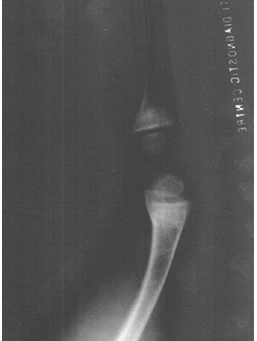
Here is a blood test confirming the likelihood of 'Ricketts'. An ALP test can be used to determine weakness and softening of the bones: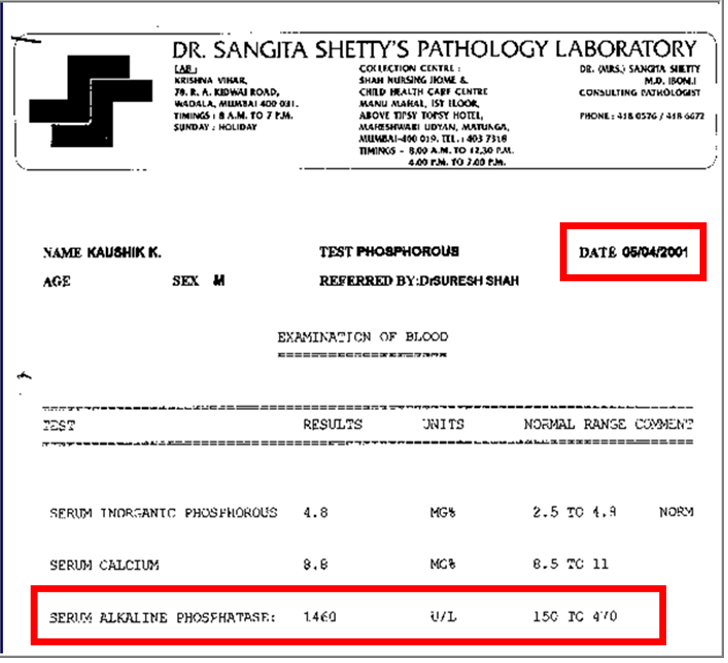
Observations of the child:
Never sits still. Mischevious, cheeky little boy. Stubborn. Ignores being told off. Has been known to hit his grandmother back after she smacked him for being naughty. Pinches you if you refuse to do what he wants. Bored easily. Mum says he laughs naughtily if he sees anyone get dressed. Dominant when playing with other children (not a bully though). Knocks toys over rather than allow another child to play with it
Kept coming round the homeopath’s desk to see what he was writing. Observant. Touching everything. Pressing keys on homeopath’s computer! Mother couldn’t control him. She shouted at him and he got angry and waved his fist at her. The homeopath decided to intervene and asked the boy sternly to stop – the boy threatened to punch him also.
Watch for yourself in this brief extract:https://youtu.be/UpJRRWi85I4
So what do we know already? Quickly and easily? We have reliable indicators from:observing the child, the nature of child and the generals of the child.
Using the S.E.A. approach described in the previous article we know the boy is:
Sociability :Approaching (no hesitancy, totally forward and approaching)
Energy : Hyperactive (cannot keep still, always moving)
Anger response : Destructive (punching, pinching, threatening)
From the case taking we also know the following :
Thermal : Hot
Thirst : Thirstless
Constitutions and Character : Disobedient - Mischevious
Here is a repertorisation in Vision: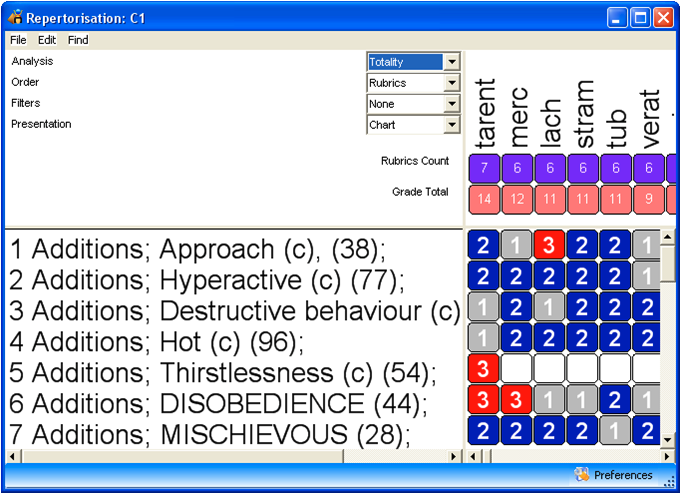
Rx : Tarentula 200c (one dose)
Xray after 6 months with before for comparison: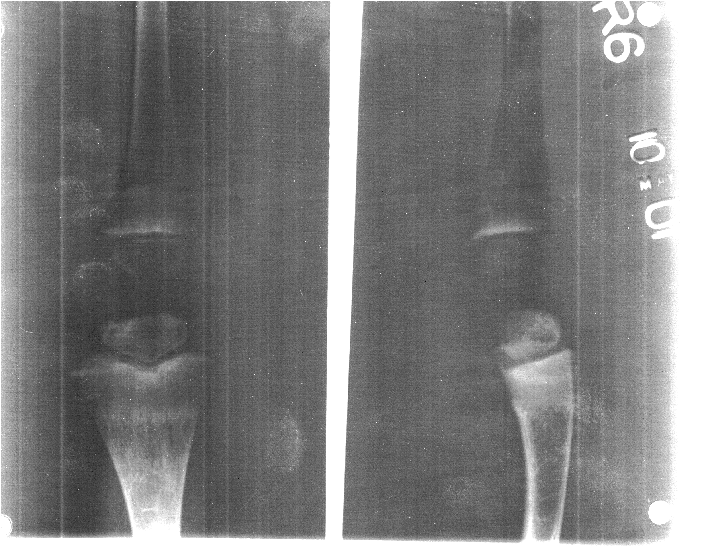
The ALP blood test was re-run after 6 months: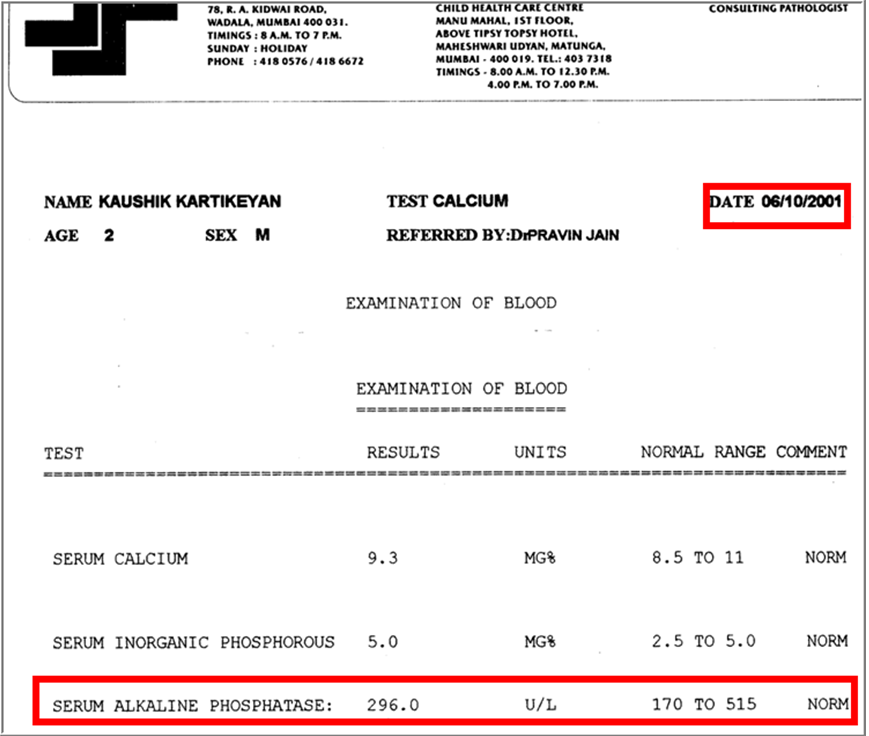
The ALP test now reveals normal levels. Success! But would you ever have considered Tarentula? Or would you have also gone for Chamomilla? This observational approach allows you to work cases out quickly through observation and at a deep level.
Our little patient is no longer Destructive and Hyperactive as the indicated remedy brings about a state of balance. However this is still an active outgoing little boy with restless tendencies – that is his real nature!
Has since twice needed Ars for acute conditions.
The observational approach and use of the S E A axis is a very practical way to observe children and not to get bogged down with simple rubric chasing. This can be seen by the first (failed) prescription of Chamomilla probably based on superficial 'symptoms' e.g. desire to be carried!
In the final article in this series I will present an additional case from Dr Jain in which the remedy was much harder to find.
Please consider integrating this approach into your practice by purchasing Dr Pravin Jain's excellent work - click for details:
http://www.miccant.com/ourshop/prod_6118350-Jains-Essence-Of-Pediatric-Materia-Medica.html
Posted on
Introduction
For many years I have supported and used an approach to case taking with children developed by my colleague and friend Dr Pravin Jain of Mumbai, India.
I have found his approach practical and immensley rewarding. To me, it feels like a refreshingly authentic approach to homeopathic case taking, rather than the almost academic theorising that seems to typify a lot of our normal case taking and analysis.
In this series of articles I am pleased to share this information with you for the first time as I think it deserves a wider audience. Feel free to comment and make suggestions below!
The Problem
Historically many homeopaths seemed to prescribe only a limited range of "commonly known child remedies". This is because information on Pediatric materia medica was limited and there was no clear approach as to how to take the case in pediatrics. So everyone seemed to be observing children in their own way and using their own interpretations of these observations. There was no methodical, scientific approach and hence, consistent results were often lacking. Senior homeopaths, because of their experience, were achieving good results, but the rest of us were perhaps not so successfull!
In Pravins own words:
"Not surprisingly, in my initial days of practice I found pediatric cases to be very difficult to treat. Shivers used to run down my spine on seeing a mother accompanied by a child at my clinic. Even before a customary “hello!”, questions like “What do I ask? How do I ask? How does one judge the constitution of a child?” would jump into my mind. Unlike adults a child doesn’t tell you about its problem. The evaluation of these cases is usually based on the history that is provided by the guardian and on the physician’s INTERPRETATION. There is no definite method to understand and prescribe for a child.
So awkward was my state that whenever a mischievous child came into my clinic, I would instruct the mother to leave the child in the waiting room and come inside alone, so that I could completely concentrate on the case taking and avoid distraction by the hyperactive child. After the information from the mother was gathered, I called in the child, and then too my focus would be more on the expensive furnishings and trinkets in the clinic than the child, for fear of those being damaged by the tiny rogue."
In summary the problem was:
1. No special pediatric repertory/rubrics to make the task easier
2. No specific pediatric case taking approach
3. Very little pediatric MM
Dr Pravin Jain decided to specialise in the area of pediatrics. He was initially inspired by reading the famous 1977 study of Thomas and Chess who identified different Temperaments in children. This approach confirmed to him that there was a way of getting to homeopathic remedies in a more structured way then simply 'rubric hunting' in the repertory based on the words of the parent.
Over the years, he has tried to streamline the 3 major aspects of prescribing as follows:
1. Formulation of a scientific method of casetaking using consistent language
2. When taking and then analysing the case - using the same language/terminology (as used during casetaking) also used in repertory rubrics
3. When arriving at a group of remedies, once again using the same language/terminology in Materia Medica to help differentiate remedies.
Again in Pravin's words:
"The birth of my own daughter raised my anxiety. There were many questions in my mind …What about vaccinations? What is her constitution? Is she chilly or hot? How is her thirst? Common questions, the answers to which a homeopath ought to know seemed to me like an abyss I feared to look down into. My anxiety led me to refer the pediatric books in great detail. Simultaneously I started honing my observation skills, observing my daughter closely. After observing her, and correlating her behavior with the pediatric psychology books, I found the key to many of my questions. The same child who used to scare me in my clinic became a joy to observe.
Now I started asking the mother to wait outside, so that the mother did not distract from my observations!"
About Pravin
Pravin first developed this way of working and analysis after many years in practice and since decided in 2002 to specialise in child care. He has opened 15 branches across India each with its own Child Observation Area (COA). Pravin places great importance on being able to observe and interact with our little patients to gain a true understanding of their nature and problems. Although you may not be able to have a dedicated COA in your clinic setting I hope that the techniques and system explained here can be taken and adapted to your own situation.
At time of writing this article Dr Jain estimates that his clinics have treated over 10,000 little patients and have been achieving consistently good results
Clinic COA's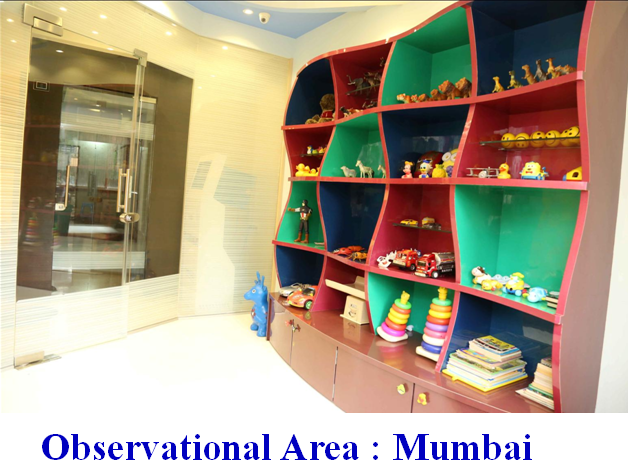
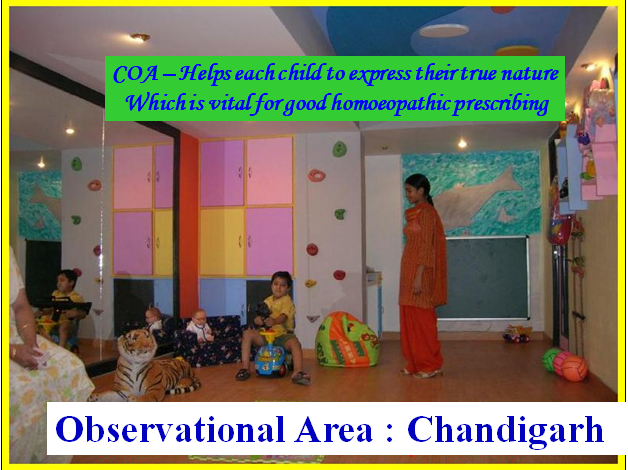
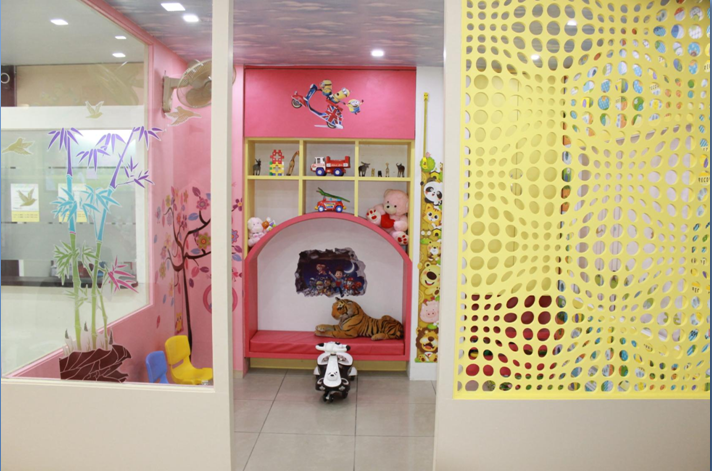
The Approach
Dr Jain finds it most important to observe and interact with children and not simply engage with the parent in 'rubric hunting'. He also analyses his pediatric cases in a very practical and straightforward way - using what is actually observed in the child's behaviour.
This article will explain in overview the approach Dr Jain takes. Subsequent articles will be cases to explain and support the approach.
For a detailed explanation and materia medica please consider purchasing Dr Jain's book 'The Essence Of Pediatric Materia Medica' which I am proud to support. To order please click on the image below :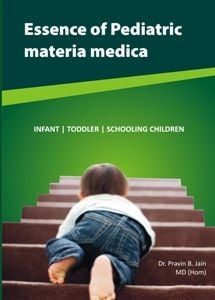
Here is an overview of the method used to observe and interact with children to arrive at well indicated remedies.
Each section will be explained in more detail below:
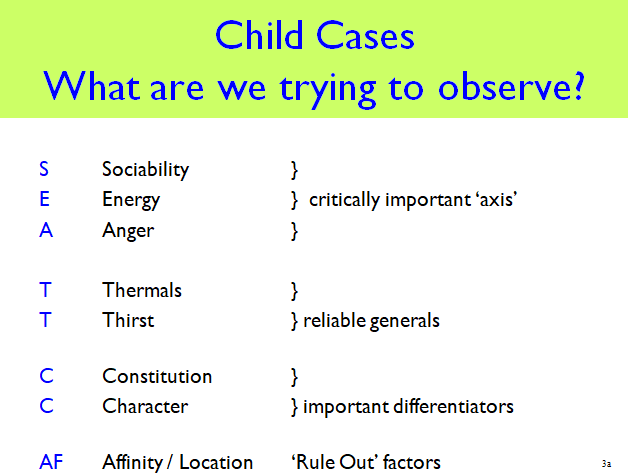
The idea is that by observation and interaction you decide on all of the above - with the 3 most important factors at the top - these are the SEA axis (Sociability, Energy, Anger).
Step 1 : Determine Sociability of child - is the child 'Approaching' or 'Withdrawing'?
This refers to the initial response to a new situation or a new stimulus. How a child responds to a new experience, such as meeting a person (guest, doctor, stranger), tasting a new food, or being in an unusual situation (doctors clinic). Observe the ease with which the child accepts and adjusts to changes in his environment and lifestyles. Some children move easily into new settings, taking very little time to join a new group of playmates, while others may observe the scene for a long time before going into a new situation or simply stay away.
Approaching children jump right in. Withdrawing children hold back cautiously until they feel comfortable.
Observation of the interaction between the child and mother, between the child and the doctor (you), between the child and a stranger, between the child and a new stimulus will help find the sociability of a child. Record this and use remedies reliably indicated and proven in practice as per this chart: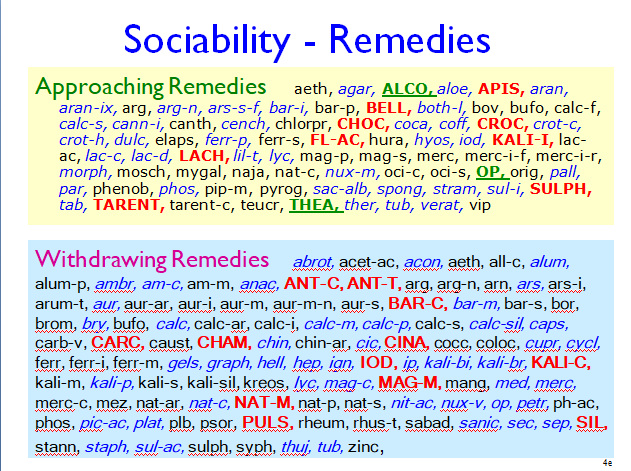
Make sure to differentiate between Mental energy/restlessness and Physical energy/restlessness as the remedies indicated for both vary! Does the child rush around the COA flitting from activity to activity? Do they engage in the more mental activities or do they stick to physical things such as running, skipping, jumping, climbing? And also look for lower than expected levels of energy.
Again there is a chart of well indicated remedies for each:
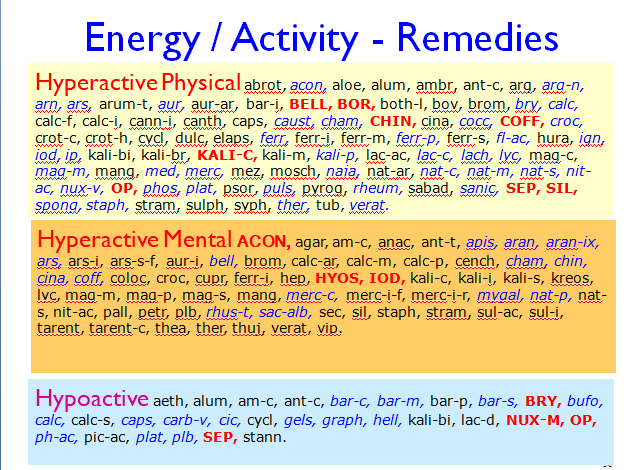
Step 3 : Determine Anger/Frustration response
If the child does not get their own way or what they desire, how do they react? You may need to interact personally with the child to make this determination!
Destructive reaction : smashing, ripping, knocking over/down, tearing paper / clothes often directed at the nearest available target
Non-destructive reaction : temper tantrum, throws themselves to floor, rolling around, writhing around, screaming loudly. Not directed at anyone or anything (unless further provoked)
Once again there is a chart of the remedies associated with each reaction:
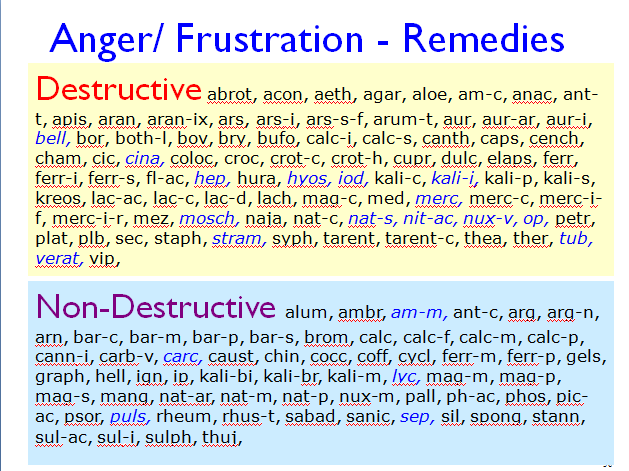
Brief example of 'Billy' and how he was analysed
A very friendly and affectionate toddler. Trouble is he’s a running and walking disaster zone! Rushes around everywhere. Throws terrible tantrums when he doesn’t get his own way and rolls around the floor shouting. He’s definitely on the ‘tubby’ side. His mother tells you he is very ‘picky’ about everything....his food and his possessions have to be ‘just so’. Can’t get to sleep at night. Wets the bed. Ezcema on hands. Mild asthma.
So Billy is:
S Approaching
E Hyperactive
A Non-Destructive
Once you have decided on the SEA axis you can quickly repertorise/cross these 3 'rubrics' to arrive at a small group of well indicated remedies. The following articles will show you real cases and analysis arrived at.
This approach allows you to spend far more time observing and interacting and less time on the technique of repertorisation - using just the 3 rubrics SEA will save you lots of time and guide you towards the indicated remedy!
Step 4 - Find the TT's!
What are the TT's? These are very reliable general modalities that help you narrow down the choice of remedy - Thirst and Temperature
Is the child thirsty or thirstless or neither? Are they hot or chilly or neither? Knowing this can be really helpful in case analysis.
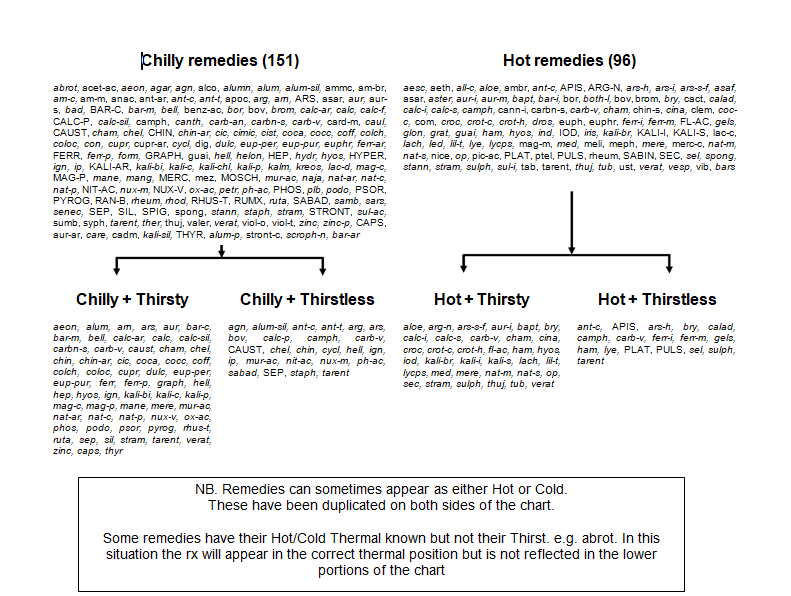
Step 5 - Find the CC's!
What are the CC's? These are the Constitution and Character of the child. Often called the Disposition and vitally important in helping you make the final choice of remedy. The Disposition or CC's either confirm or reject the remedy prescription as the disposition of the child absolutely must correspond with the known disposition of the remedy.
Examples - is the child : Happy? Neat and tidy? Do they do as they are asked e.g. could you please tidy up all these toys? (obedient) Are they Shy or Bashful? Are they a Bully? Are they Confident? Are they Rude? Do they Complain or Moan a lot? And so on.
Conclusion to First Article
In the next article I will present a worked case with repertorisation and follow up so you can see the approach in action!
Please comment on this article below. I read every comment personally and will reply if appropriate and I am sure Dr Jain would appreciate your feedback also.
Thank You
David Witko
FSHom UK (Hon)
Posted on
The Meditative remedies have been in use since the 1990's. These are a set of over 80 remedies drawn from a variety of sources. Each of these was proven using a new approach. The author of these proving volumes is Madeline Evans. (alternative books have also been published by Colin Griffiths). The remedies can be purchased from Helios Pharmacy in UK. Before discussing the Meditation Provings in more detail a quick review of the more traditional proving methods is warranted:
Provings are a foundation stone of homeopathy. From provings comes a basis on which to determine what symptoms and illnesses substances cause and therefore cure in potentised form and they are the source of much of our information. The original provings were a mixture of recorded poisonings (toxicology) and the effects of crude substances originally tested on animals and later taken by human volunteers.
Nowadays provings are almost exclusively conducted with homeopathic potencies not crude substances. In an attempt to improve the quality of provings many modern provings are conducted double or even triple blind in an attempt to remove 'bias' from the findings. However our original bedrock provings were not done in that way. Many homeopaths experimented on themselves in the full knowledge of what they were taking - and they faithfully recorded their findings and published them in materia medicas as provings. Many of the things they experienced have become entrenched in our homeopathic literature and form the basis of much of the information we still use today!
Other Approaches
Sankaran has used dream provings and especially a 'collective consciousness' approach to help understand the sphere of action of a substance. As Sankaran himself said "My own personal contact with Jurgen Becker inspired me to start group-provings in Bombay, especially after I had noted seemingly indifferent results with the Hahnemannian method. " and also "the effects of the substance seem to multiply when it is given to a group, rather than to a set of individuals having no contact with each other."
Sherr is perhaps renowned as being responsible for the resurgence of a more traditional proving approach. In his book Dynamic Provings he says "During a proving, strange and wonderful phenomena occur, events which defy conventional scientific reasoning but which are in total accordance with the broader wisdom of homeopathic perception."
Of course it is important to remember that Hahenmann himself and other contemporaries did not adhere to what some call the ‘strict Hahnemannian’ style of proving. They regularly experimented on themselves and admitted their experiences into the proving materials.
Scholten employed a Group Analysis for new and existing remedies in his Minerals, Elements and Lanthanides books. This controversial method allowed homeopaths to inspect groups of remedies and predict the symptoms they might be useful in. Using this information in practice proved quite successful although many remain unconvinced to this day. It is very interesting to note this statement in his book Lanthanides : "The information in this book comes from a mixture of sources. The first source is provings. Most provings in this book are meditation provings instead of classical full provings"
Some homepaths consider the 'original' proving data to be sacrosanct. "Why do we need new provings they ask? What we have already is plenty and good enough". Whilst revering Hahnemann they refer back to the seminal works of Allen and Hering constantly. To them I offer a quotation from Hughes and Dake in the under-appreciated work 'Cyclopedia of Drug Pathogensy' published in 1885 referring to Allen's Index of Materia Medica (10 volumes of collated provings) he says "It has laid the foundation of the Materia Medica of the future, though itself cannot be so regarded; ....... let us repeat - a large part of the Encyclopedia of Pure Materia Medica is untrustworthy, and the work must be done over again".
In my opinion all new material should be examined, put to the test and evaluated in practice in order to arrive at a conclusion. Nothing should ever be ridiculed or ignored simply because of dogmatic thinking.
Having set the scene regarding provings and admitting differing approaches that have proven successful in every day use I would like to introduce the Meditation Provings that arose in the 1990's.
About the Meditation Provings
The remedies that arose as a result of these meditative provings have been in use for many years gradually growing in popularity as awareness of them grew within the homeopathic community.
Method of Meditation Provings
All of these remedies were examined by meditation circles. The leader of a circle knew what the source of the remedy was. In the beginning all participants knew what the remedy was as the purpose of the meditation was not to conduct a remedy proving as such but was done for the group’s own spiritual healing and intuitive development. As the provings progressed and as people started to hear about them and other homeopaths started to use them, the provings started to be conducted 'blind'. Without wishing to alienate those with differing belief systems but in the interests of full disclosure it is significant to note that sometimes 'channelled information' was also received and recorded as directed.
At the time none of the participants realised that these new remedies would become as widely known and used as they have become. They did not keep the records that tell us when the provings changed from a known to an unknown remedy. But what was evident was that for most provers, knowing or not knowing the remedy made no difference at all, whilst for others, and one in particular, there was a difference in the nature and quality of the information on the remedy.
“The remedies presented have been drawn solely from provings and do not include anything intuited by individuals outside the parameters of the provings. No extrapolations have been included as to states, conditions or diseases the remedy might treat based on the proving symptoms. I have also deliberately included spiritual teachings related to the remedy pictures, as reading the remedies is in itself a constant reminder of our spiritual selves.” Madeline Evans
Should any eyes have glazed over at the use of the word ‘spiritual’ could I perhaps remind you of Hahnemann’s words?
“Nevertheless the incredible variety among patients as to their irritability, their age, their spiritual and bodily development, their vital power and especially as to the nature of their disease, necessitates a great variety in their treatment, and also in the administration to them of the doses of medicines.” Chronic Diseases
“This dynamic action of medicines, like the vitality itself, by means of which it is reflected upon the organism, is almost purely spiritual in its nature..” Lesser Writings
List Of The Meditative Remedies
Colours
Blue, Green, Orange, Purple, Rainbow, Red, Yellow
Gems, Crystals
Amethyst, Ametrine, Chalcancite, Emerald, Jade, Jet, Moldavite, Moonstone, Peridot, Phantom quartz, Obsidian, Rhodocrosite, Rose quartz, Ruby, Sapphire, Tiger’s Eye
Minerals
Caesium, Clay, Natrum flouratum, Plutonium, Selenite, Slate, Spectrolite, Strontium
Flowers and Trees
Almond, Apple tree, Ash, Ayahusaca, Banyan Tree, Bay leaf, Bog asphodel, Brown rice, Buddleja, Chestnut Red, Chestnut White, Conium, Copper beech, Cotton, Forget-me-not, Frankincense, Goldfish, Hazel, Himalayan Blue Poppy, Holly, Holly Berry, Hornbeam, Kigelia, Lotus, Mimosa, Nettle, Oak, Okoubaka, Olive, Rose (pink), Sandalwood, Sea Holly, Sea Salt, Sequoia, Silver birch, Snowdrop, Strawberry, Sycamore seed, Viscum album, Willow, Wych-elm
Animals and Insects
Butterfly (Red Admiral), Earthworm, Silverfish,
Human
Lac humanum, Medorrihinum, Thymus gland
Other energies
Berlin Wall, Chalice Well Water, Ether, Milky Way Galaxy
For all of these remedies the usual mental and physical symptoms are given but also "each remedy's spiritual aspects and the way in which it can be used to clear psychic or spiritual blocks and to further spiritual development. The provings bring to the forefront the spiritual potential of Homeopathy and give to practitioners and patients who are ready and willing to work at this level the possibility of using homeopathy as a tool for spiritual advancement." Madeline Evans.
Mediative Provings within the Vision software
There are 3 books connected with meditative provings contained within Vision, namely :
which are collectively referred to in Vision as the Meditative Pack.
The repertory is contained in entirety. You can choose to work exclusively with this repertory which is very nicely presented in a modern appealing design. Alternatively you can integrate its use alongside all the other repertories in your system. The style of the repertory is similar to that of Knerr’s Repertory of Hering’s Guiding Symptoms, i.e. rather than breaking up proving expressions into individual word parts, the full expressions have been preserved as rubrics.
In addition to the standard chapters you will find in all repertories you will find chapters and rubrics in this repertory that you will not find elsewhere. Example chapters are : Astrological, Environment, Esoteric, Miasms and there are other useful chapters such as Diseases & Conditions, Dying, Emergency, Sensations and Toxicity. Here is an example taken from the Emergency chapter:
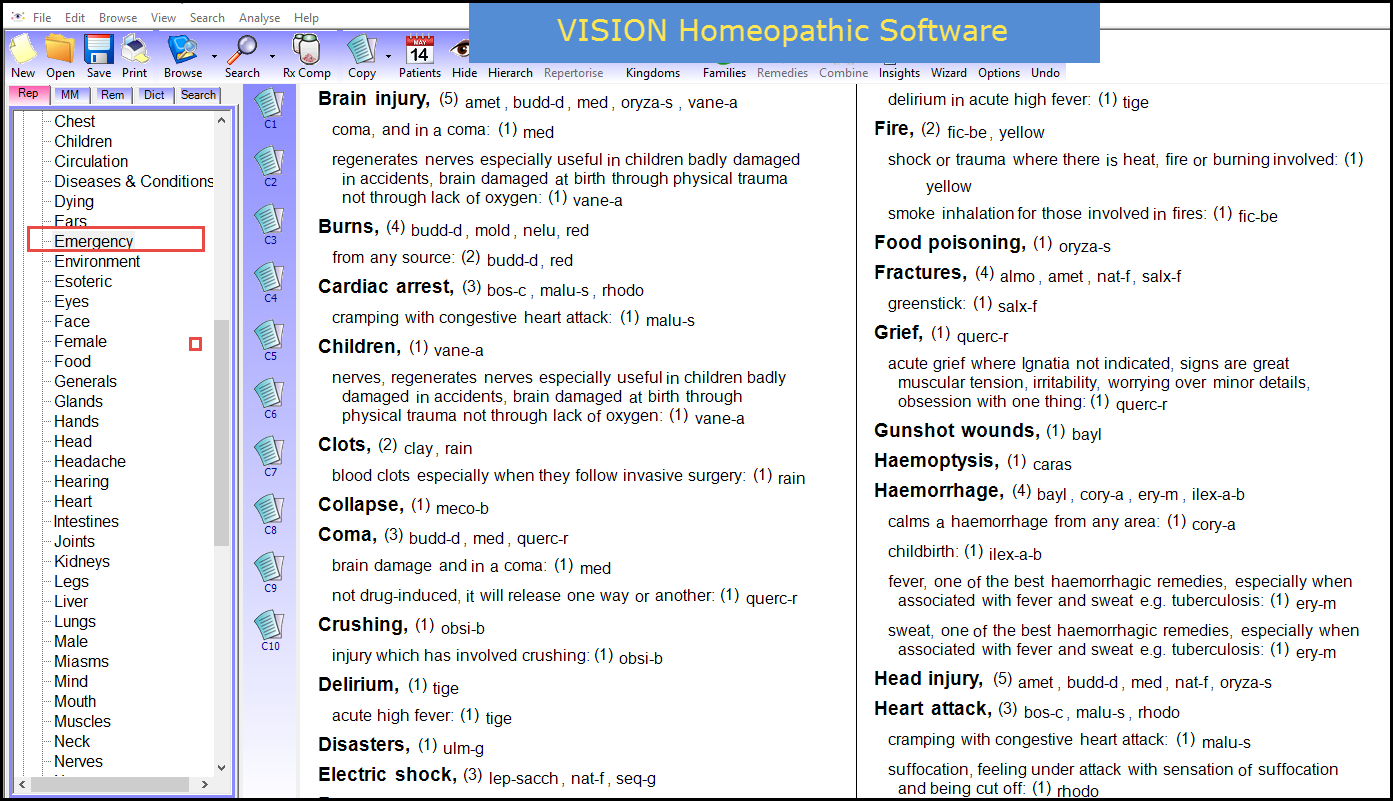
Another good example of the use of the meditative remedies is when searching materia medica for specific words. Let’s say you were looking for more information about a child with AUTISM that you were treating. Perhaps you had repertorised in the usual way but it was ineffective. A search for AUTISM quickly reveals information contained within the meditative remedies that you would otherwise not have access to!
Here is an example in Vision clearly showing how the modern language used in these remedies can be very helpful:
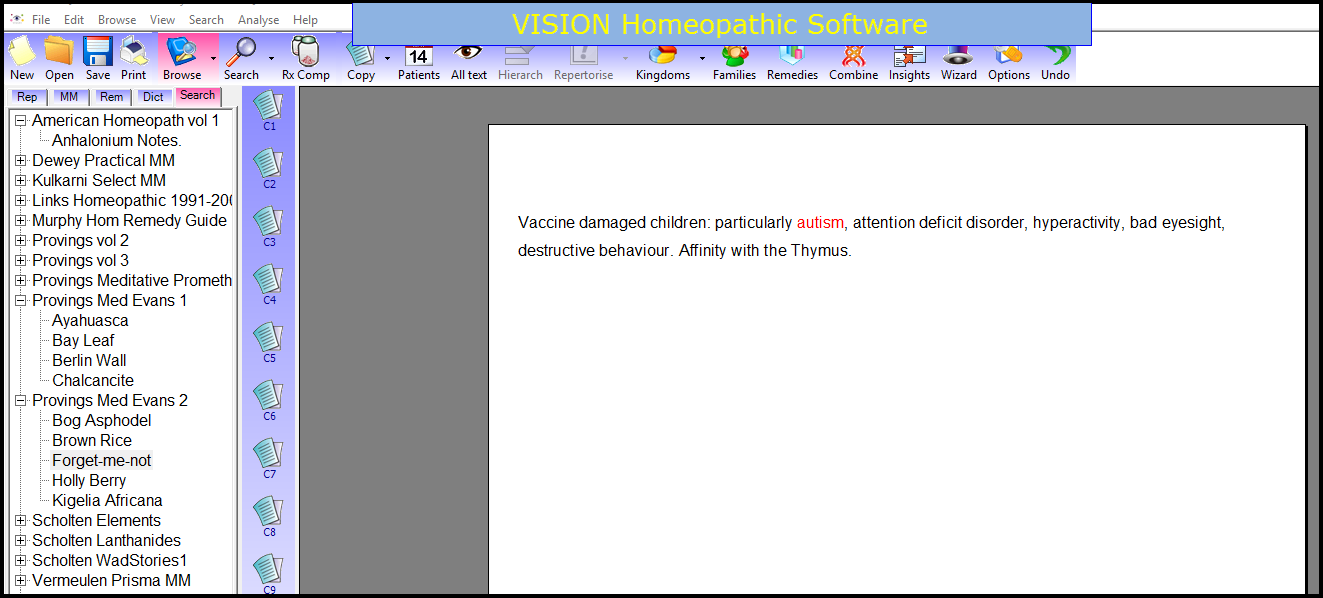
The remedy displayed is the beautiful flower ‘Forget-Me-Not’ (Myosotis symphytifolia).
One of most common queries I receive when new remedies are added into the repertory is this: “This new remedy is displayed in my case analysis....how can I read up about it?” And the answer is usually ‘You cannot – please reference the original proving!”
When using the Meditative Pack you always have access to the data in the 2 volumes of materia medica. So whether simply browsing the repertory or directly from a repertorisation you have quick access to the original text.
Here is an example of Chalcancite:
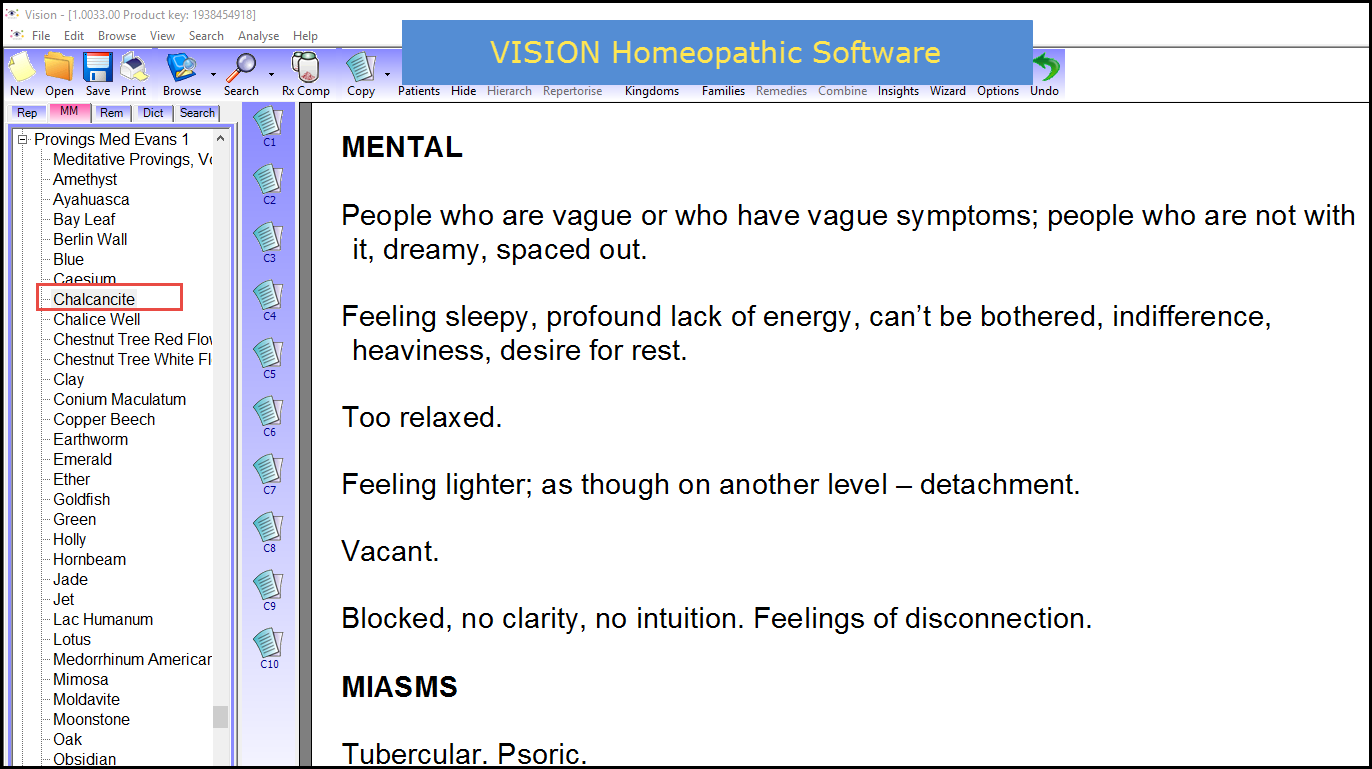
Summary
The remedies within the Meditative Provings offer an alternative approach to homeopathic prescribing. For those used to a very traditional approach to case analysis these remedies may seem unusual and the description of their use may not be familiar to you. As Madeline Evans has said “The provings bring to the forefront the spiritual potential of Homeopathy. Many of the older remedies do not have this aspect as they were needed at a time when the level of humanity's development was different.”
In my experience it can be most helpful to use these remedies separately to the usual repertories. Use the Contemporary Repertory as a direct index to find the exact rubric(s) you need, cross one or two rubrics to see if a remedy runs through and then consult the proving volumes to read in detail about each. Use your own intuition and feeling to make the final selection.
When you are ready to work in this way and should you wish to consider a different approach when your usual approach does not give the hoped for outcome, why not try these remedies?
If you are a user of the Vision software you can easily add these remedies to you system. Click here to learn more
Comments Received About The Meditative Provings and Repertory
I LOVE this meditative repertory...incredible stuff! I will use this so often I can’t even begin to tell you.....thank you thank you thank you!!! Kim Kalina
Thank you so much for the repertory. What a tome! What dedication you both have had to spend three years at it. Well done! I have not had much time to get into it with anything like the attention it deserves but what immediately strikes me is the clarity of the typesetting, the ease with which one can find one's way about and unfussiness of the whole enterprise. It is refreshingly unpretentious. Colin Griffith
Many many thanks for the repertory. It is wonderful, a real timely asset to our prescribing of new remedies. A wonderfully dedicated work, well presented and beautifully illustrated. I am very impressed with this book. It certainly presents all that I could have wished for in a repertory when I first set out on the adventure of meditative provings many years ago. The work and dedication put into this should be an inspiration to us all. May all who use this work be blessed with much insight and healing. Janice Micallef
This is a refreshing piece of work – the cover and end papers are young and vibrant, and speak of the global aspects of the provings. The rubrics are written in modern English and have been neither interpreted nor translated from the provings. Having sentences [rubrics] that read as we speak, instead of the usual inverted rubric form, makes easy reading and clear comprehension. There are many cross-references to facilitate one’s search. Jenni Tree
We use this Repertory along with the Meditative Provings at Dhanvanatari College of Homeopathy. It is a wonderful book, and such an easy to use repertory! Well done " Dhanvantari Dasi
Posted on
After several years of development I released the ISIS homeopathic software in 2003. ISIS has gone through several advancements and transformations in the past 13 years, with v2 being released in 2005 and ISIS Vision being released in 2007.
I originally chose the name ISIS in representation of the Egyptian and then Greco-Roman deity of 'Health and Wisdom'. I thought it was a fitting name for my new homeopathic software. The name ISIS was originally suggested to me by Paul and Yolande Grill and I willingly embraced it.
For the past few years I have often been advised that, due to the emergence of 'so-called' Islamic State, the name ISIS had acquired a bad association. This situation has recently got even worse with major institutions and some corporations even preventing Miccant emails containing the word 'ISIS' from being permitted on their servers. Homeopaths would tell me, and I would see posts on Facebook, that they were 'frightened' to even click on our links for fear of what might be associated with them.
It is with great regret that I have decided to change the name of the software. From now on it will be known simply as : Vision. I know that many of you, like myself, have become very attached to the name ISIS and will be very sad about this announcement. Unfortunately I can see no alternative having resisted for as long as I could.
Currently we are preparing our new revised website which will also remove all references to ISIS and replace it with Vision. As this new website has started to roll-out around the world I would like to share this new website with you when it is thoroughly tested and ready for use.
Please feel free to make any comments in the section below. I would like to know how you feel about this decision. Wherever appropriate I ask you to share this announcement with your friends and colleagues to make sure they do not think that ISIS is 'stopping' but simply 'transforming' into Vision.
David Witko FSHom UK (Hon)
Posted on
Jeremy Sherr's latest edition to his QRep is available with Vision. Here is a video you can watch to learn more:
If you prefer to read....
QRep edition 2 adds:
The New Qualities
Big Ego
Excessive selfishness, pride, vanity, self-importance, over emphasis on bodily appearance (sign of ego).
Birds and Flying
Any fears, dreams, delusions related to birds and flying. Also applies to fear of flying.
Fear Disease
Overanxiety about health issues or disease in themselves or others. Hypochondriacs.
Insects
Phobias, fear, dreams about insects. Also love and sympathy towards insects.
Judgemental
Critical, fault finders, nit-pickers in others and also themselves. Social media trolls and judemental people.
Newly proven remedies added to all of QRep
Lots of new remedies have been added into QRep. Here is a list:
Colibri Hummingbird - African Grey Parrot - Red Kite - Egg of the Blue Peafowl - White Stork (feather only) - White Stork (feather and blood) - Mallard - Indian Spotted Eagle - Tangerine - Acacia Strap flower Mistletoe - Rocky Mountain Columbine - Lepidolite - Blue Tang Fish - Black Panther - Queen Bee - Nest of the Common Wasp - Shrill Carder Bee - German wasp - Cat Flea - Stag Beetle - Crab Louse - Black Fly - Blue Emperor Butterfly.
Each has been carefuly curated by Jeremy and his team
Enhancements to existing qualities
Adjustments to the grades of remedies in existing qualities has been made. Newly proven remedies added to existing qualities.
QRep is a repertory you can purchase to use with your Vision software. Please watch the vidoe above for a full presentation and also guidance on how to use alongside other repertories within Vision.
http://www.shop.miccant.com/ourshop/prod_2544985-Repertory-of-Mental-Qualities.html
David Witko Fellow Society of Homeopaths UK (Hon)
Posted on
Should you need to move your data to a new computer please use this procedure as a guide.
Make sure you take a Backup of all your Vision data. You should be doing this regularly anyway (to protect against computer failure) but it is always good to take a final backup!
To take a Backup : with Vision started, click the File menu, and choose item Backup/Restore. You will see this screen:
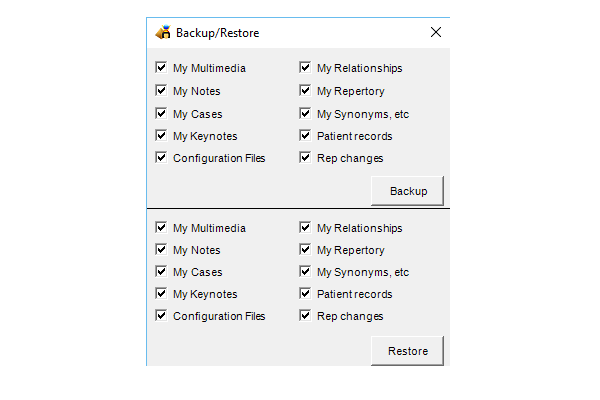
In the top half of the screen you can see that everything is ‘ticked on’. Vision provides the flexibility to backup specific items even if you haven’t used all areas of Vision. Normally you would leave all items ‘ticked on’ for maximum safety.
Should you be upgrading from Vision v1 to Vision v2 there is one item you may not want to backup. This is the item marked 'Configuration Files'. These configuration files contain your colour settings and preferences. When upgrading it is best if you do not overwrite the defaults with settings from Vision v1. We suggest you manually change the settings in Vision v2 when upgrading from Vision v1. So switch this item off.
When you click the Backup button Windows will ask where you want to save your backup file. We suggest you save the file in a location you can easily find later – the Desktop is always a good choice! Or your Cloud folder if you secure your files on the cloud.
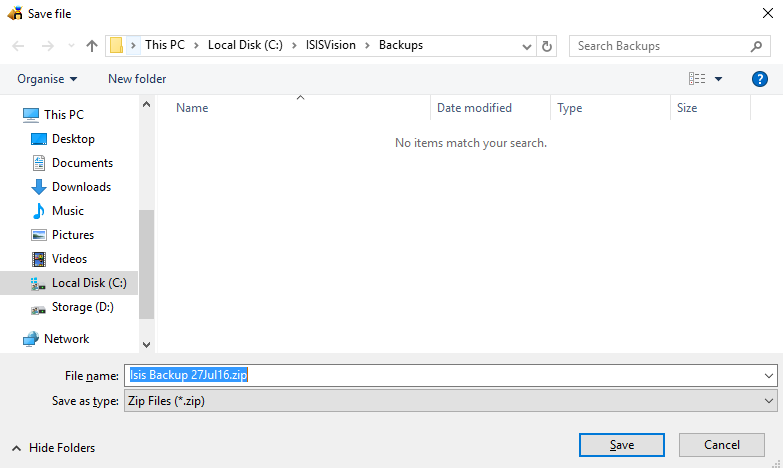
Once Windows has saved your backup file then you need to safely copy this file to your new computer. You could use a USB memory stick for example. You would copy the backup file just saved onto your computer and then copy that file to your USB memory stick.
Some prefer to backup all of their Vision data online in the cloud with a service like Microsoft’s Onedrive, Google Drive, Apple Cloud Drive or Dropbox. If you use this kind of service simply copy the Vision backup file to your cloud upload folder and let that service take care of it for you.
Once you have the backup file copied to a USB memory stick or it has been uploaded/downloaded to/from the cloud then go to your new computer, start Vision, click the File menu and choose the Backup/Restore item once again.
This time click the Restore button leaving all items ‘ticked on’, select your Vision backup file and let Vision restore all of your data for you. You may receive informative messages while this is happening and it may take a while for Vision to restore everything for you if you have lots of data to restore
Once it is all finished you will be ready to use Vision on your new computer with all of your data!
Posted on
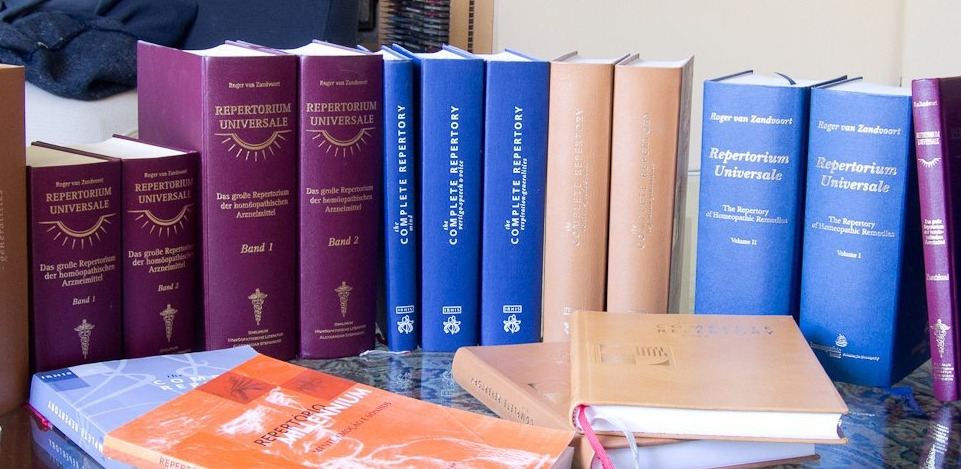
A lot of work went into this release of the Complete Repertory version 2016. In previous years Roger mostly concentrated on remedy additions from cured cases. However this time an original materia medica and repertory, (Carl Friedrich Trinks’ Handbuch der homoöpatischen Arzneimittellehre from 1847), has been added.
This is considered a primary materia medica much like Hahnemann’s seminal Materia Medica Pura, only it contains more remedy provings and toxicology. Trinks was a very early disciple of Hahnemann (see edited biography later in this document)
It is important to note that this work has never been translated into English and therefore few English materia medica and repertories since 1847 have had access to this material.
For Complete Repertory 2016 a huge effort has been made to include the provings/toxicology symptoms from Trinks’Handbuch der Arzneimittel 1847 in 3 volumes, by taking the rubrics and remedies from the repertory section in the third volume and merging those into the Complete Repertory.
This work has resulted in over 275,000 source additions into Complete Repertory 2016.
Trinks work is one of the few that make a clean separation between provings/toxicology and any clinical/cured material coming from practice, so it is considered a true primary Materia Medica.
A very nice detail in Trink’s opus is the fact that all remedies have been graded using Bönninghausen’s grade system (of course : given the date of preparation!), resulting in lowest degree, plain type, and second degree, italics, additions. These additions, combined with already available information from practice (cured cases) will often increase the grading from lowest or second degree (i.e. provings/toxicology or single cured case-additions without proving/toxicology) to third or even fourth degree additions (provings/toxicology AND cured) which will make analyses with ISIS Vision that includes Complete Repertory 2016 much more refined.
Often Trinks data has been already been verified by other authors and so has already been included in the repertory. However a quick examination using Complete 2016 with ISIS Vision shows there are many new additions made that we now have access to! Please also bear in mind that these are additions made on the basis of sound provings and toxicological reports in the classical way
Here is a screenshot of just one rubric: anxiety, with pain. Trinks is author number 4 in our classification system and the additions he has made to Complete 2016 are highlighted as below. And this is just 1 rubric in the entire repertory.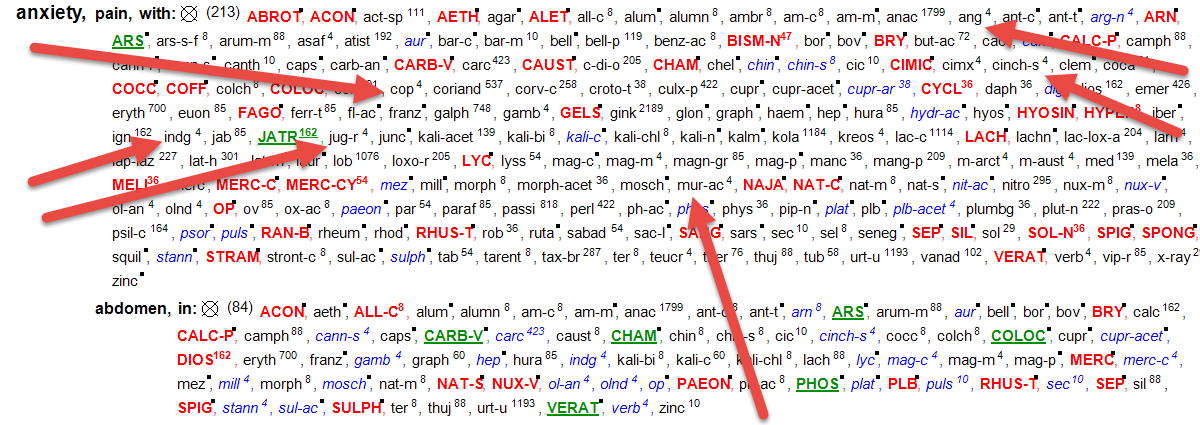
In addition to Trinks’ work, around 760 more articles from the Homoeopathic Recorder and to a lesser degree from the British Homoeopathic Journal have been read and remedies from these have been added into the Complete Repertory 2016. Also as a reaction on a promise made during a repertory workshop with George Vithoulkas around the year 2000 in Alonnisos for those working on repertory, in which it was concluded that much more cured case-info should be added into the existing repertory material, - for this edition of the Complete Repertory nearly 3000 sources have been consulted since then to update the repertory with more cured material.
Charles Friedrich Gottfried Trinks (1800-1868)
(taken from on online article translated by Dr Bradford and edited by David Witko)
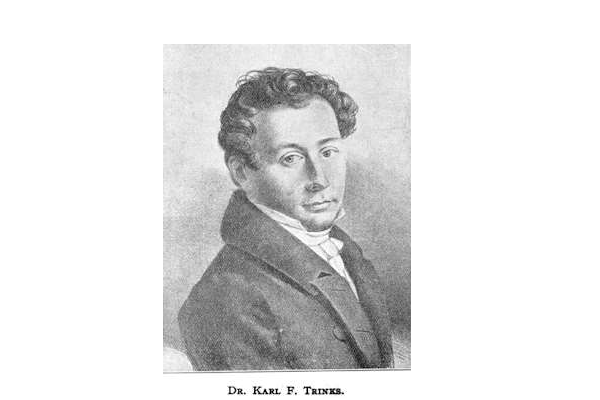
One of Hahnemann's earliest disciples, he was also one of the greatest gains to the new system. A man of indefatigable industry and self-sacrifice, he contributed largely to the construction of the Homoeopathic Materia Medica, and his name will be found constantly recurring among the band of provers who aided Hahnemann in his Herculean task.
In conjunction with Noack, (or we should say almost single-handedly for Noack soon gave up) he published the Materia Medica that bears their joint names.
Hahnemann, whom he frequently saw on the promenade at Leipsig, he visited first at Coethen in 1825, again in 1832, and once, subsequently, with Councillor Wolf. In 1824 Trinks settled in Dresden. He and Ernst von Brunnow were the earliest Homoeopathists there.
In 1830 Trinks attended the first meeting of Homoeopathic physicians held at Leipsig, and assisted in the foundation of the Central Society of German Homoeopathic Physicians.
The only volume of importance published by him was that in which he was a joint author with Noacks - the well-known Noack and Trinks' Handbook of Materia Medica ; but the essays he has contributed to the periodical literature of Homoeopathic medicine are numerous.
This preference for fact over theory, his love for the real rather than the ideal, contributed largely to make Trinks what he was: a thorough physician.
Homoeopathy he loved, because in its school alone did he meet with that full development of the principle of pure observation he felt to be so necessary for the practice of medicine.
A thoroughly independent thinker, it was not long before he found himself somewhat opposed to Hahnemann ; and on one occasion he had a discussion with Boenninghausen, when Boenninghausen endeavoured to introduce mixed medicines into the practice of Homoeopathy.
He most earnestly opposed everything in the shape of mysticism, everything having the aspect of humbug with which it was sought to connect Homoeopathy. On these grounds he declared himself an enemy of the so-called high potencies and a supporter of the lower dilutions.
At an early period of the history of Homoeopathy, when Hahnemann was in danger of being led away by some of his enthusiastic but incautious disciples to promulgate crude and untested notions, Trinks' common sense prevailed with the founder of Homoeopathy and prevented him from committing himself to views that could not stand the test of experience.
Trinks' manner to one seeing him for the first time was often blunt and even somewhat repulsive. His dietetic rules for those under his care were very rigid, his prescriptions, carefully selected, were adhered to with a tenacity which, though often regarded as unwise by those around him, was generally rewarded by satisfactory results.
Throughout the North of Germany Trinks was regarded as the most distinguished physician who had practiced Homoeopathy since the time of Hahnemann.
Dr. Trinks died at Dresden. June 15, 1868, at the age of sixty nine years. (Brit. Jour. Hom., Vol. XXVI, p. 693.)